Special Report
Every State's Rules for Staying Open and Social Distancing
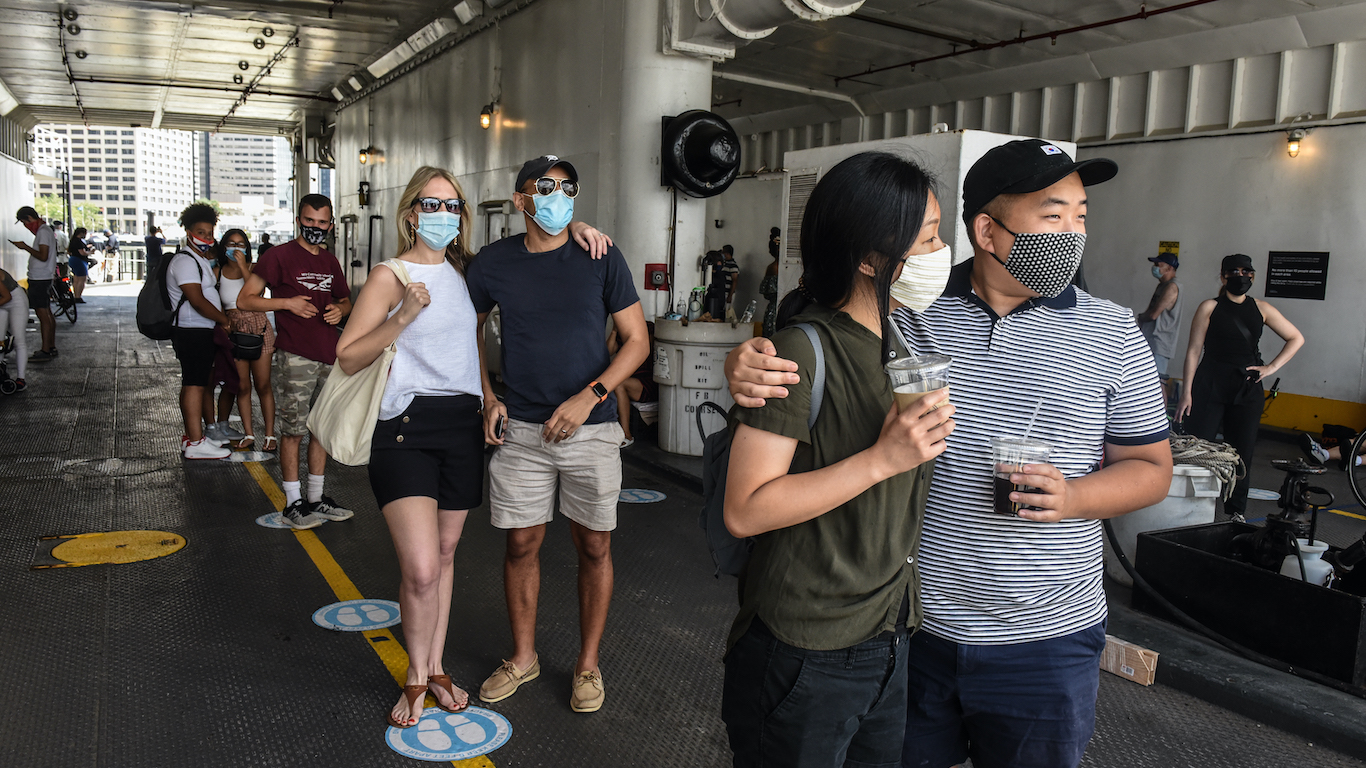
Published:

The U.S. set a new record in new coronavirus cases in one day, reporting more than 67,000 cases on July 15, up from the 60,000 record a week earlier. Some of the increase has been the result of increased testing, but not all, as hospitalizations in many states have also been rising. Still, spikes in new COVID-19 cases have been reported in most states across the country in recent weeks. Many states are taking action and are halting plans for further reopening.
To determine each state’s social distancing measures and rules for reopening, 24/7 Wall St. reviewed executive orders from state governors over the last few weeks.
No states are considering, at least as of yet, an option to return to a complete shutdown. But more states are mandating that people wear masks when they are anywhere in public, especially in enclosed spaces.
As COVID-19 is spreading faster than ever, there are significant variations in how states are deciding to continue opening their economies and allow people to gather again. The U.S. averaged more than 62,000 new cases a day in the week between July 8 and July 15, about three times the average a month ago.
Across the country, there were nearly 3.5 million cases of COVID-19 as of July 15, or about 500,000 more than just a week ago. The concentrations in active cases are not evenly spread across the country, and the hotspots of the virus are changing — these are the cities where COVID-19 cases have doubled in two weeks.
Click here to see every state’s rules for reopening and social distancing

Alabama
> Cumulative COVID-19 cases as of July 15: 1,155 per 100,000 people — 15th biggest (total: 56,441)
> COVID-19-related deaths as of July 15: 23 per 100,000 people — 23rd biggest (total: 1,136)
> Total tests administered as of July 15: 10,808 per 100,000 people — 24th smallest (total: 528,275)
> Change in trailing 7-day avg. daily cases, June 7 – July 14: 24.7% — 9th biggest increase (from 45,263 to 56,441)
> Population: 4,887,871
Through July 31, Alabama is under a Safer at Home order. Restaurants in Alabama are open but customers must maintain 6-foot social distancing protocols. Entertainment venues, such as arcades, movie theaters, and bowling alleys are also allowed to open, but there must be no waiting lines, people have to wear masks, and customers have to be separated by at least 6 feet. Sports practices have resumed, and games are allowed to take place.
There is no statewide mandate to wear masks, though some counties are making face coverings a requirement when people are in public places. As of July 10, there are 39 out of 67 counties in the very high risk category, which means the coronavirus in those counties is widespread.
[in-text-ad]
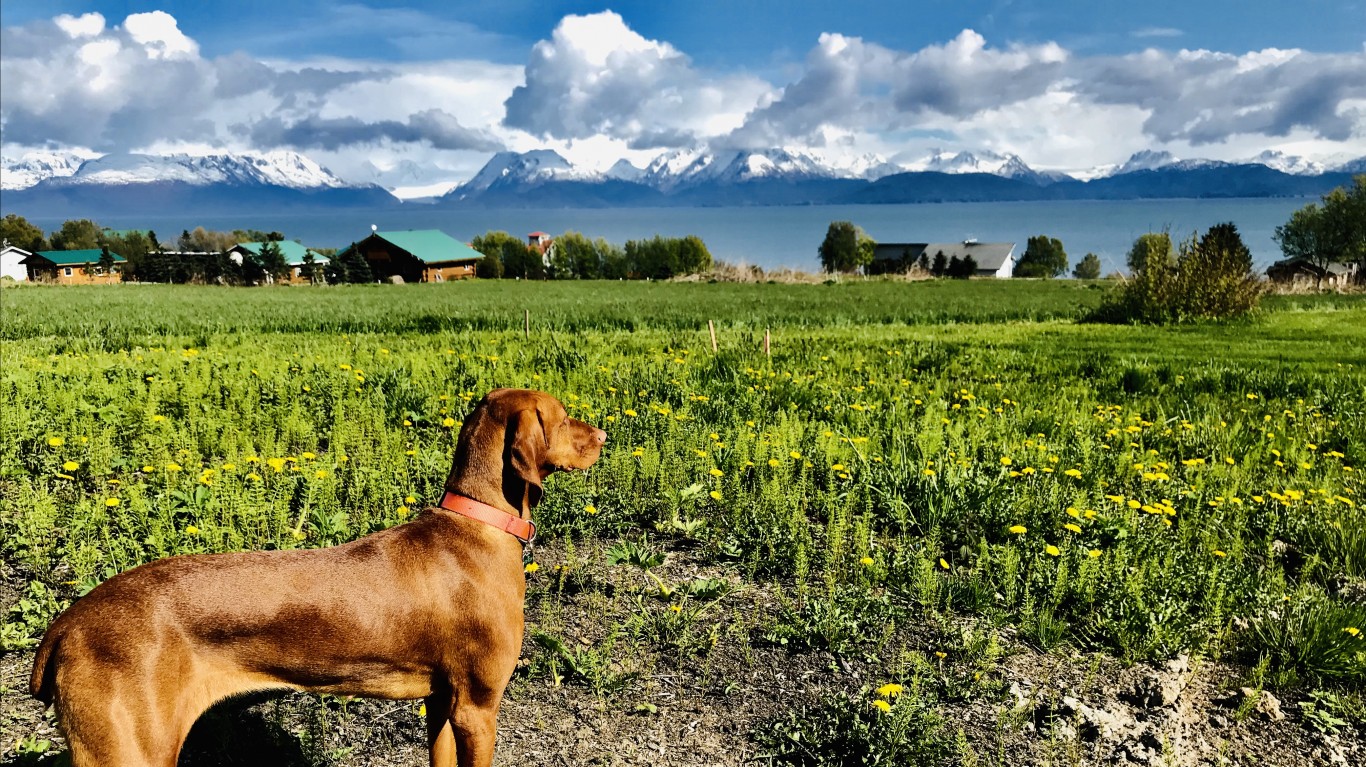
Alaska
> Cumulative COVID-19 cases as of July 15: 214 per 100,000 people — 4th smallest (total: 1,579)
> COVID-19-related deaths as of July 15: 2 per 100,000 people — 2nd smallest (total: 17)
> Total tests administered as of July 15: 20,269 per 100,000 people — 4th biggest (total: 149,473)
> Change in trailing 7-day avg. daily cases, June 7 – July 14: 33.4% — 4th biggest increase (from 1,184 to 1,579)
> Population: 737,438
Travelers arriving into Alaska from another state or country have to follow new protocols. They must complete a traveler declaration form and either present results of a negative COVID-19 test taken within the previous 72 hours or take a test upon arrival and self-quarantine until results are known. Travelers can only use road or maritime highways, and travel to remote areas is restricted to essential travel.
Alaska is in phase 3 of reopening. All businesses (in full capacity), religious gatherings, libraries, museums, recreational activities, and sport activities can open.
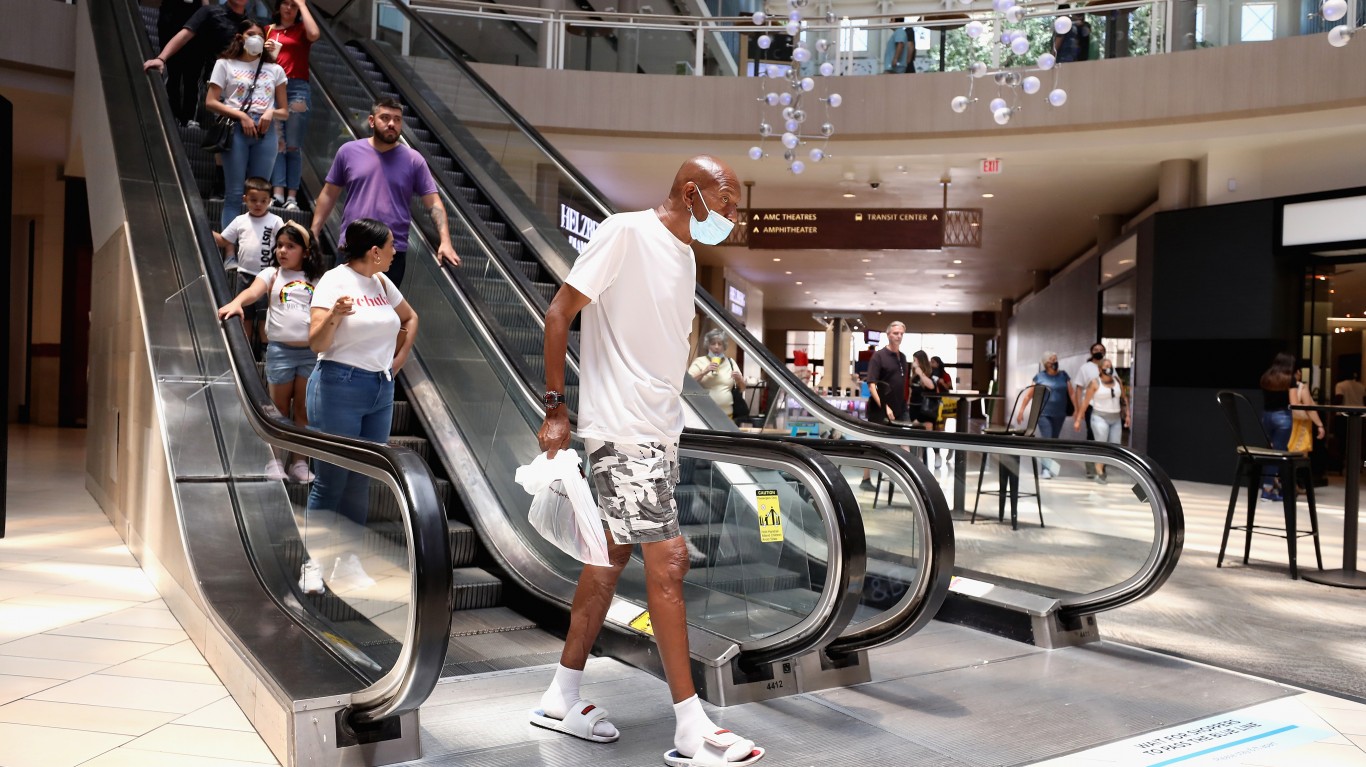
Arizona
> Cumulative COVID-19 cases as of July 15: 1,786 per 100,000 people — 3rd biggest (total: 128,097)
> COVID-19-related deaths as of July 15: 33 per 100,000 people — 14th biggest (total: 2,337)
> Total tests administered as of July 15: 10,056 per 100,000 people — 19th smallest (total: 721,191)
> Change in trailing 7-day avg. daily cases, June 7 – July 14: 21.9% — 12th biggest increase (from 105,094 to 128,097)
> Population: 7,171,646
Arizona is among the states where COVID-19 cases have been surging in recent weeks. Gov. Doug Ducey issued an executive order on June 29 that prohibits gatherings of more than 50 people. Bars, gyms, movie theaters, water parks, and tubing rentals have closed, again, for a month. The first day of school for in-person instruction has been delayed to August 17.
Businesses are required to keep employees and customers at least 6 feet apart and to demand that all in the business wear face covering whenever possible. There is no statewide requirement for people to wear masks, but local governments can implement their own mask and face covering policies and determine enforcement.
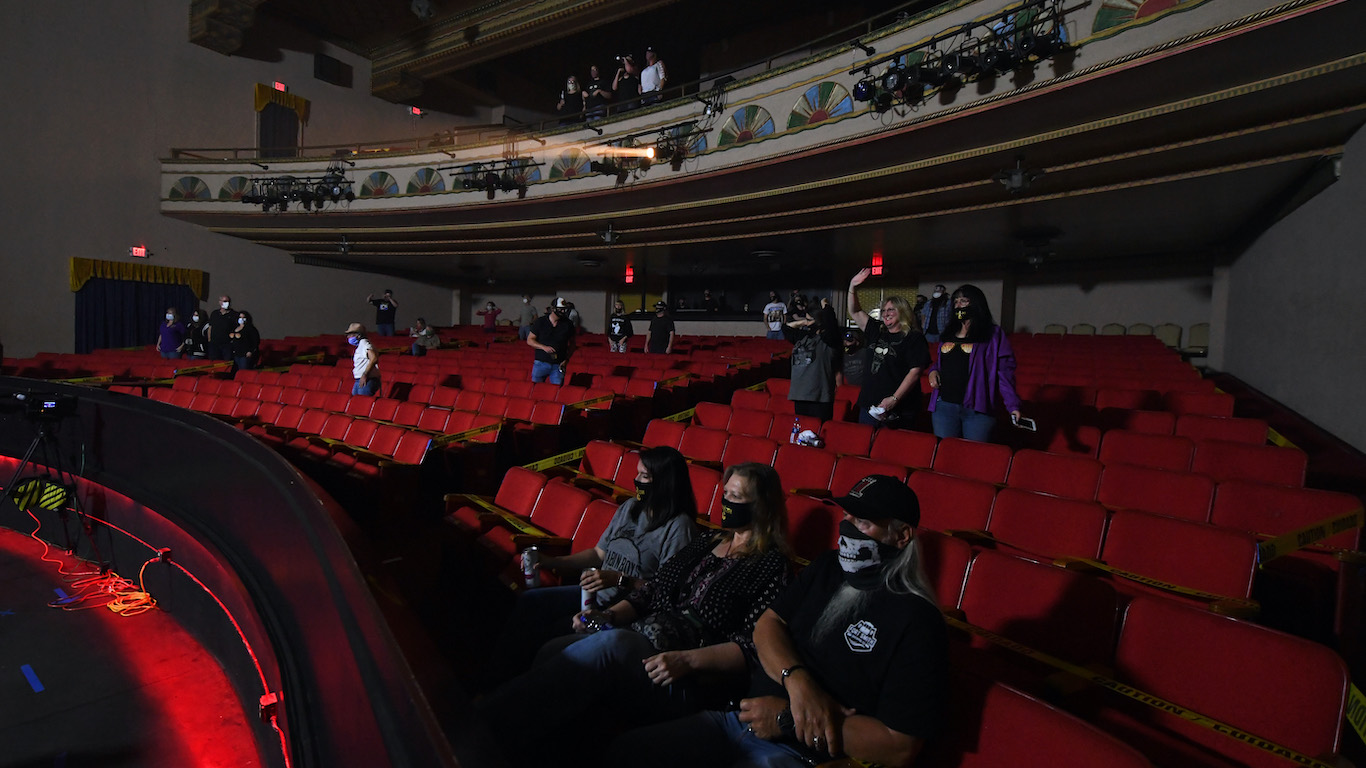
Arkansas
> Cumulative COVID-19 cases as of July 15: 987 per 100,000 people — 18th biggest (total: 29,733)
> COVID-19-related deaths as of July 15: 11 per 100,000 people — 13th smallest (total: 331)
> Total tests administered as of July 15: 13,113 per 100,000 people — 18th biggest (total: 395,212)
> Change in trailing 7-day avg. daily cases, June 7 – July 14: 22.6% — 11th biggest increase (from 24,253 to 29,733)
> Population: 3,013,825
Arkansas is in phase 2 of reopening. Restaurants and other businesses can now expand to two-thirds capacity, up from a third of capacity under phase 1. Summer day camps are open, but class sizes are limited to no more than 10 people. Camp enrollment is limited in order to allow proper physical distancing.
High school and community sports teams are allowed to resume practice under strict measures. Short-term rentals such as hotels, motels, and vacation rentals are limited to “authorized guests,” which include national guard members, first responders, homeless people, and journalists. Long-term care facilities such as nursing homes resumed limited visitation.
[in-text-ad-2]

California
> Cumulative COVID-19 cases as of July 15: 851 per 100,000 people — 25th smallest (total: 336,508)
> COVID-19-related deaths as of July 15: 18 per 100,000 people — 23rd smallest (total: 7,087)
> Total tests administered as of July 15: 14,346 per 100,000 people — 13th biggest (total: 5,674,955)
> Change in trailing 7-day avg. daily cases, June 7 – July 14: 21.1% — 13th biggest increase (from 277,774 to 336,508)
> Population: 39,557,045
A stay-at-home order that has no set end date and is still in effect. New coronavirus cases have been surging over the last few weeks in California. In a major rollback, restaurants, museums, and movie theatres have been ordered to cease indoor operations statewide, again. Bars must shut down completely. In addition, gyms, and other businesses that provide service indoors must close in 30 counties, representing about 80% of California’s population.
Californians must wear masks or other face coverings while in public or in high-risk places such as stores, public transit, or hospitals.
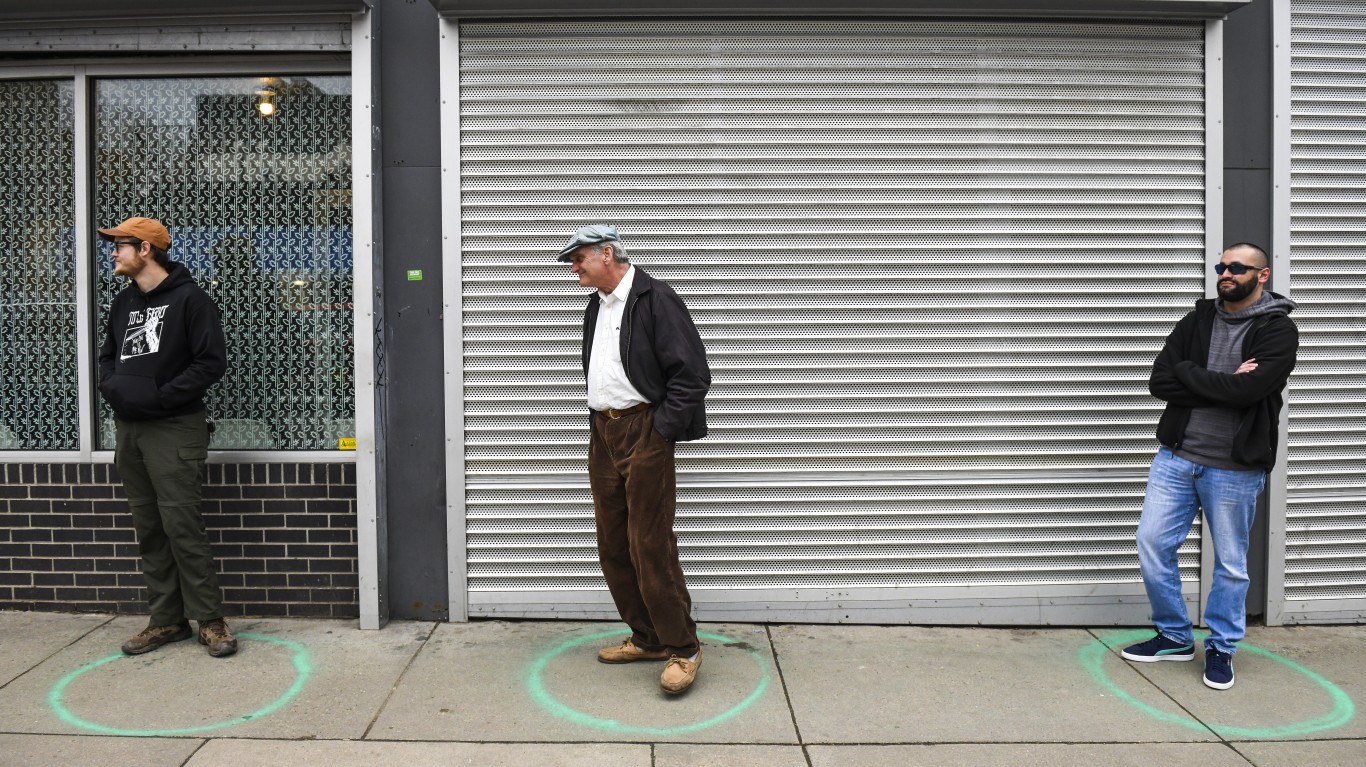
Colorado
> Cumulative COVID-19 cases as of July 15: 662 per 100,000 people — 17th smallest (total: 37,686)
> COVID-19-related deaths as of July 15: 31 per 100,000 people — 15th biggest (total: 1,738)
> Total tests administered as of July 15: 7,145 per 100,000 people — 9th smallest (total: 406,967)
> Change in trailing 7-day avg. daily cases, June 7 – July 14: 8.7% — 18th smallest increase (from 34,664 to 37,686)
> Population: 5,695,564
Colorado is under a Safer at Home and in the Vast, Great Outdoors order, which encourages people to maintain social distancing when they go outside. Bars and nightclubs have been ordered to close again amid rising coronavirus cases. The rule does not apply to bars that have taken steps to open as restaurants and have customers sit 6 feet apart.
All activities and social gatherings are allowed but at 50% of pre-pandemic capacity with people being at least 6 feet apart or at no more than 500 people in one setting at a time.
[in-text-ad]

Connecticut
> Cumulative COVID-19 cases as of July 15: 1,330 per 100,000 people — 9th biggest (total: 47,530)
> COVID-19-related deaths as of July 15: 122 per 100,000 people — 3rd biggest (total: 4,372)
> Total tests administered as of July 15: 16,508 per 100,000 people — 7th biggest (total: 589,778)
> Change in trailing 7-day avg. daily cases, June 7 – July 14: 1.1% — 2nd smallest increase (from 47,033 to 47,530)
> Population: 3,572,665
Connecticut postponed phase 3 of reopening indefinitely due to a surge in new coronavirus cases in other states.
Summer camps are allowed to open, in compliance with state requirements. Barbershops, hair salons, and tribal casinos can also reopen. Bars remain closed until further notice. Outdoor gatherings of up to 25 people are allowed, in compliance with social distancing protocols of 6 feet apart and wearing of masks. Child care facilities are limited to 50 kids. State campgrounds opened for the season on July 8.
Delaware
> Cumulative COVID-19 cases as of July 15: 1,349 per 100,000 people — 8th biggest (total: 13,050)
> COVID-19-related deaths as of July 15: 54 per 100,000 people — 11th biggest (total: 521)
> Total tests administered as of July 15: 14,826 per 100,000 people — 12th biggest (total: 143,388)
> Change in trailing 7-day avg. daily cases, June 7 – July 14: 4.5% — 9th smallest increase (from 12,414 to 12,969)
> Population: 967,171
Delaware is in phase 2 of reopening. Phase 3 was supposed to begin on June 29 but was delayed indefinitely. Beach bars in the Rehoboth and Dewey area have been either closing or limiting operations due to an increase in the number of new cases and positive test rate.
Retail stores, restaurants, and other businesses can open at 60% capacity. Child care facilities are allowed to open for all families, not just children of essential workers, with group size limits. People are urged to continue working from home if possible. Personal care services such as massage therapy are now allowed to reopen at 60% capacity. Outdoor gatherings are allowed but with no more than 250 people. Recreational sports tournaments can resume. People are required to wear face coverings in public settings, including stores, doctor’s offices, and public transportation.
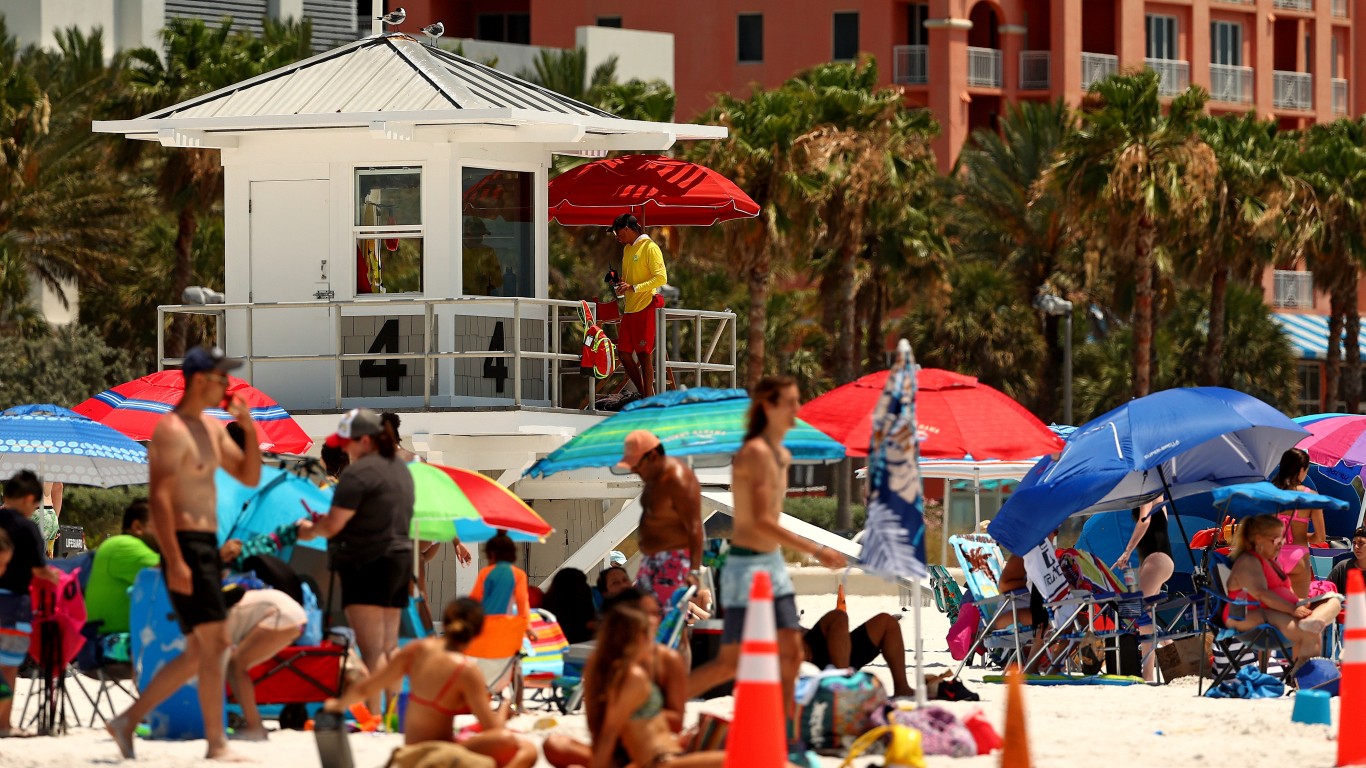
Florida
> Cumulative COVID-19 cases as of July 15: 1,417 per 100,000 people — 7th biggest (total: 301,810)
> COVID-19-related deaths as of July 15: 21 per 100,000 people — 24th biggest (total: 4,521)
> Total tests administered as of July 15: 12,860 per 100,000 people — 19th biggest (total: 2,739,169)
> Change in trailing 7-day avg. daily cases, June 7 – July 14: 36.4% — 3rd biggest increase (from 213,794 to 291,629)
> Population: 21,299,325
The state has yet to set a date for the start of phase 3, when bars, restaurants, gyms, and other businesses will be able to resume operations at full capacity and when sporting events will be open for fans. Florida has to have a downward trend of new coronavirus cases before phase 3 is implemented. This may not happen soon as the state is experiencing a surge of COVID-19 cases, with young people comprising most of the new cases. Restaurants in Miami are closing for dine-in services after being open for a few weeks. Gyms, party venues, and short-term rentals have also been ordered to close. People are asked to gather in groups of no more than 50 people with social distancing.
In other parts of the state, under phase 2, bars and pubs may operate dine-in service at 50% capacity inside and full capacity outside. Movie theaters and entertainment venues can operate at 50% capacity also. Two Disney World theme parks in Florida have recently reopened.
[in-text-ad-2]

Georgia
> Cumulative COVID-19 cases as of July 15: 1,178 per 100,000 people — 14th biggest (total: 123,963)
> COVID-19-related deaths as of July 15: 29 per 100,000 people — 16th biggest (total: 3,054)
> Total tests administered as of July 15: 10,752 per 100,000 people — 23rd smallest (total: 1,131,034)
> Change in trailing 7-day avg. daily cases, June 7 – July 14: 19.2% — 18th biggest increase (from 101,126 to 120,569)
> Population: 10,519,475
Though the novel coronavirus in Georgia is spreading fast, with the state reporting record new highs at the beginning of July, the state is not halting further reopening. Most social gatherings of more than 50 people are banned, unless there can be 6 feet of distance between every person. Amusement park rides, carnivals, circuses, and water parks can open, in compliance with health requirements. Restaurants no longer have a limit on how many people can sit at one table or on the number of customers per square foot. Bars can now have 50 people or 35% of full capacity, whichever is greater.
Live performance venues have been allowed to open if they meet certain criteria. Exhibitions, trade shows, conferences, business retreats, and other conventions can now be held, too. Overnight summer camps are open but people can attend only if they have tested negative for COVID-19 within 12 days.
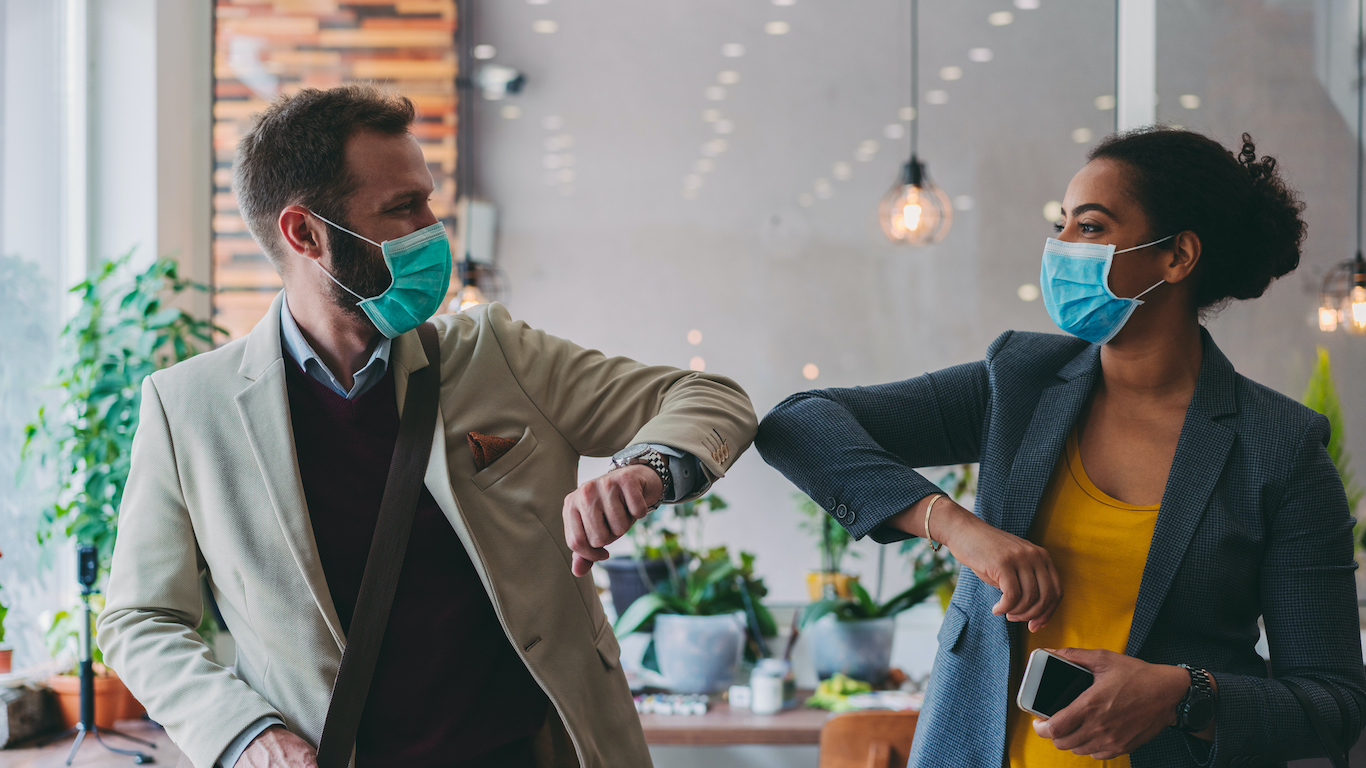
Hawaii
> Cumulative COVID-19 cases as of July 15: 89 per 100,000 people — the smallest (total: 1,264)
> COVID-19-related deaths as of July 15: 2 per 100,000 people — the smallest (total: 22)
> Total tests administered as of July 15: 8,186 per 100,000 people — 12th smallest (total: 116,275)
> Change in trailing 7-day avg. daily cases, June 7 – July 14: 20.7% — 15th biggest increase (from 1,030 to 1,243)
> Population: 1,420,491
The state lifted the 14-day quarantine requirement for those traveling between islands on June 16, but it is requiring thermal screening at the airport. Travelers may be prevented from flying if they have a temperature above 100.4 degrees Fahrenheit. After Sept. 1, people visiting Hawaii who test negative up to three days prior to arriving in the state won’t have to self-quarantine.
Beaches are open for recreational activities and as long as social distance is maintained. Malls, car washes, nonemergency medical visits, and retailers can open. The state is in phase 2 of reopening, allowing indoor gathering places and exercise facilities, as well as museums, theaters, personal services, and dine-in restaurants to reopen.
[in-text-ad]
Idaho
> Cumulative COVID-19 cases as of July 15: 668 per 100,000 people — 18th smallest (total: 11,718)
> COVID-19-related deaths as of July 15: 6 per 100,000 people — 7th smallest (total: 103)
> Total tests administered as of July 15: 7,590 per 100,000 people — 11th smallest (total: 133,142)
> Change in trailing 7-day avg. daily cases, June 7 – July 14: 45.5% — 2nd biggest increase (from 8,052 to 11,718)
> Population: 1,754,208
Idaho is in phase 4 of reopening. Counties in phase 4 will remain in it for at least two weeks due to a recent rise in new COVID-19 cases in the state. Ada County, which includes Boise, was moved back to phase 3 with bars closing their doors after being open for a few weeks.
In phase 4, gatherings of more than 50 people are allowed where social distancing can be practiced. Nonessential travel is permitted to locations without ongoing transmission of the virus. Bars and movie theaters can reopen if they meet safety protocols. Restaurants can allow more than six people at one table. Employees can return to offices if they practice social distancing. The state still encourages face mask use and maintaining 6 feet of distance from others in public.
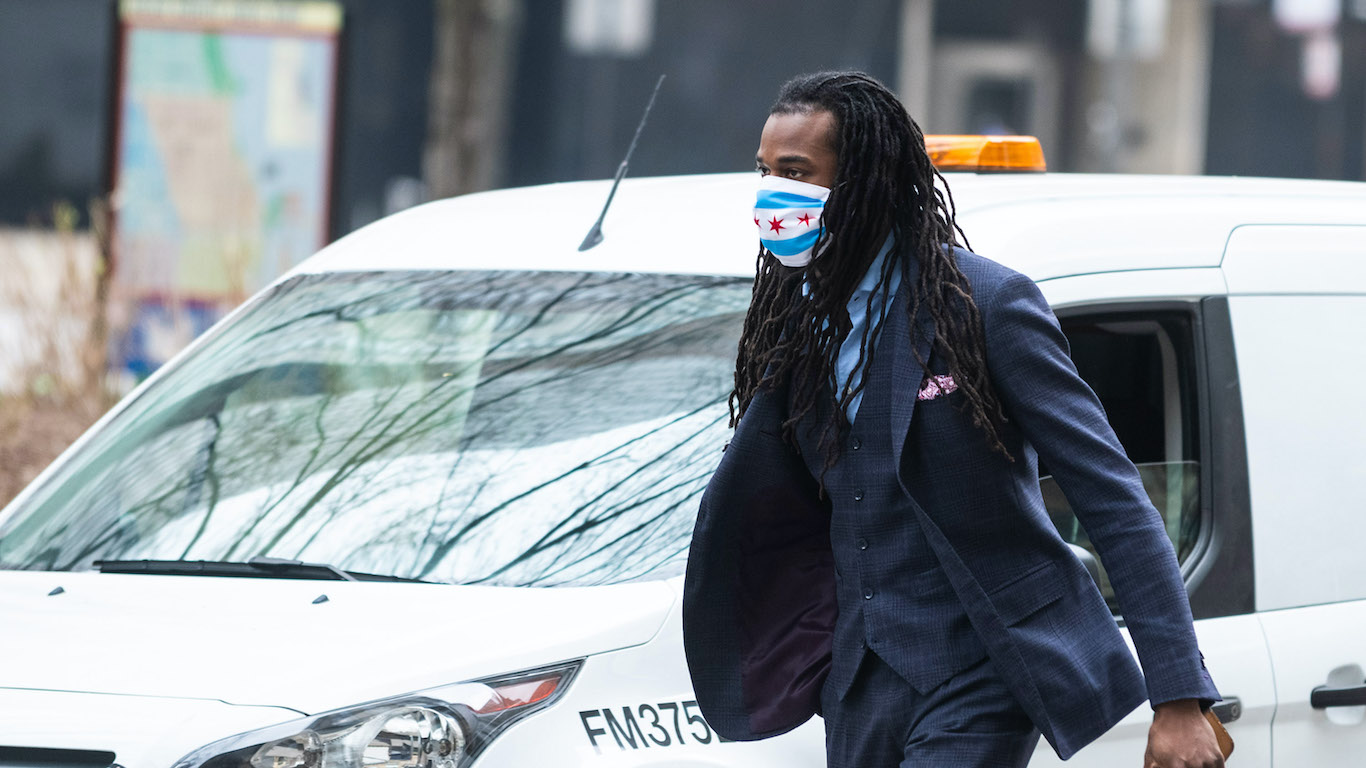
Illinois
> Cumulative COVID-19 cases as of July 15: 1,221 per 100,000 people — 12th biggest (total: 155,506)
> COVID-19-related deaths as of July 15: 57 per 100,000 people — 8th biggest (total: 7,218)
> Total tests administered as of July 15: 16,023 per 100,000 people — 9th biggest (total: 2,041,440)
> Change in trailing 7-day avg. daily cases, June 7 – July 14: 4.8% — 10th smallest increase (from 148,452 to 155,506)
> Population: 12,741,080
The state remains in phase 4 of reopening. The limit on social gatherings expanded from 10 in phase 3 to 50 people. Businesses in sectors such as health, fitness, movies, theaters, museums, and zoos can either open or expand capacity limits. Indoor dining can resume with groups of no more than 10 people, with tables spaced 6 feet apart in seated areas. Standing areas can’t exceed 25% of capacity. Indoor movie theaters can admit no more than 50 guests or 50% of full capacity. People must wear masks or face coverings in public places where they cannot maintain 6 feet of distance from others.
Gov. J.B. Pritzker said on July 14 that he would issue orders to close bars and indoor dining, as well as impose other restrictions on businesses, if the spread of COVID-19 did not slow down across Illinois.

Indiana
> Cumulative COVID-19 cases as of July 15: 787 per 100,000 people — 24th smallest (total: 52,685)
> COVID-19-related deaths as of July 15: 39 per 100,000 people — 13th biggest (total: 2,582)
> Total tests administered as of July 15: 8,643 per 100,000 people — 14th smallest (total: 578,409)
> Change in trailing 7-day avg. daily cases, June 7 – July 14: 8.3% — 16th smallest increase (from 48,626 to 52,685)
> Population: 6,691,878
Indiana is in phase 4 of reopening. Restaurants can expand indoor dining to 75% capacity. Bars, nightclubs, bar seating in restaurants, movie theaters, bowling alleys, and similar entertainment facilities can open at 50% capacity with social distancing rules in place. Recreational sports can resume with restrictions. Amusement and water parks can open at 50% capacity with restrictions. The Department of Motor Vehicles resumed walk-in services, but driving skills exams are still not available.
Most restrictions will remain in place at least through July 17. Effective July 1, K-12 schools could begin operations for the 2020-2021 academic year. Fairs, festivals, and similar large outdoor events can now take place. The final phase 5 of reopening has no set date yet due to a rise in COVID-19 cases and hospitalizations.
[in-text-ad-2]
Iowa
> Cumulative COVID-19 cases as of July 15: 1,135 per 100,000 people — 16th biggest (total: 35,830)
> COVID-19-related deaths as of July 15: 24 per 100,000 people — 21st biggest (total: 756)
> Total tests administered as of July 15: 12,081 per 100,000 people — 22nd biggest (total: 381,301)
> Change in trailing 7-day avg. daily cases, June 7 – July 14: 12.2% — 20th smallest increase (from 31,927 to 35,830)
> Population: 3,156,145
Iowa’s casinos are allowed to reopen, as well as amusement parks, bowling alleys, pool halls, and arcades. Bars and other establishments that serve alcohol can reopen for indoor and outdoor seating. However, some restaurants and bars in major Iowa cities are voluntarily choosing to temporarily close doors again as COVID-19 cases have been surging in big urban areas.
Businesses, including gyms, could begin to operate at full capacity with social distancing, hygiene, and public health measures. Swimming pools, indoor playgrounds, theaters and performance venues, senior citizen centers, and adult day care facilities can reopen in compliance with state guidance.

Kansas
> Cumulative COVID-19 cases as of July 15: 689 per 100,000 people — 19th smallest (total: 20,058)
> COVID-19-related deaths as of July 15: 10 per 100,000 people — 11th smallest (total: 288)
> Total tests administered as of July 15: N/A
> Change in trailing 7-day avg. daily cases, June 7 – July 14: 18.7% — 19th biggest increase (from 16,901 to 20,058)
> Population: 2,911,510
Kansas is in phase 3 of its reopening plan. Due to spikes in coronavirus cases in some areas, local health officials recommend that phase 3 be delayed. Social gatherings of up to 45 people are now allowed, up from 15. Bars and restaurants must preserve a 6-foot distance between tables, booths, and barstools. Casinos and indoor leisure spaces can open as well. Nonessential travel may resume.
Statewide, people are required to wear face coverings when they are in public. But local governments can overturn the order.
[in-text-ad]
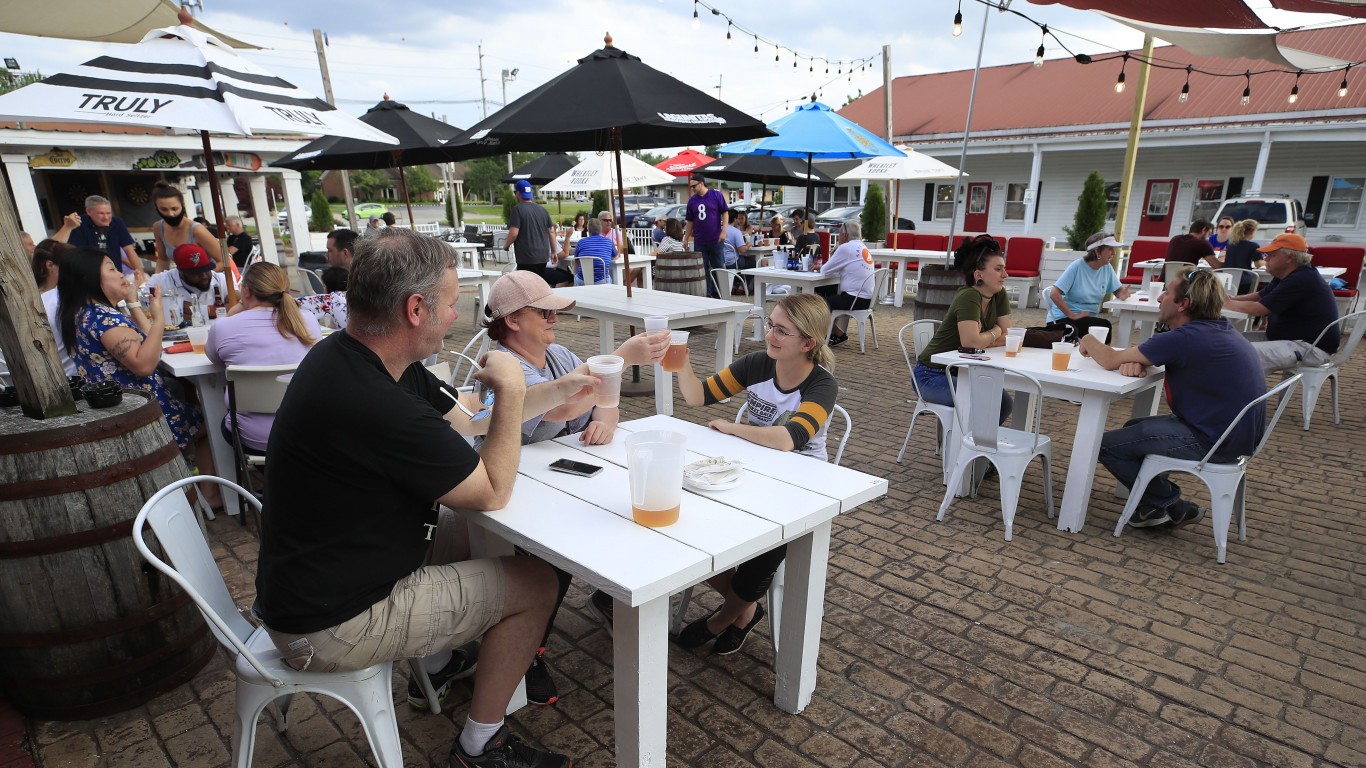
Kentucky
> Cumulative COVID-19 cases as of July 15: 453 per 100,000 people — 10th smallest (total: 20,223)
> COVID-19-related deaths as of July 15: 14 per 100,000 people — 19th smallest (total: 635)
> Total tests administered as of July 15: 10,175 per 100,000 people — 21st smallest (total: 454,682)
> Change in trailing 7-day avg. daily cases, June 7 – July 14: 15.4% — 25th biggest increase (from 17,519 to 20,223)
> Population: 4,468,402
Movie theaters and fitness centers are allowed to reopen in Kentucky. So are museums, outdoor attractions, aquariums, libraries, and distilleries. Child care services can reopen as well with reduced capacity. Restaurants and bars can expand capacity to 50% or more as long as people not from the same household can be 6 feet apart. Masks or other facial coverings are now required when people are in public.
Outdoor seating is unlimited. Businesses that were permitted to operate at 33% capacity since May 22 have been allowed to increase capacity to 50% since June 22, provided they comply with guidelines. Effective June 29, gatherings of up to 50 people have been allowed, but people must maintain physical distancing. NASCAR races returned to the Kentucky Speedway with no live audience.
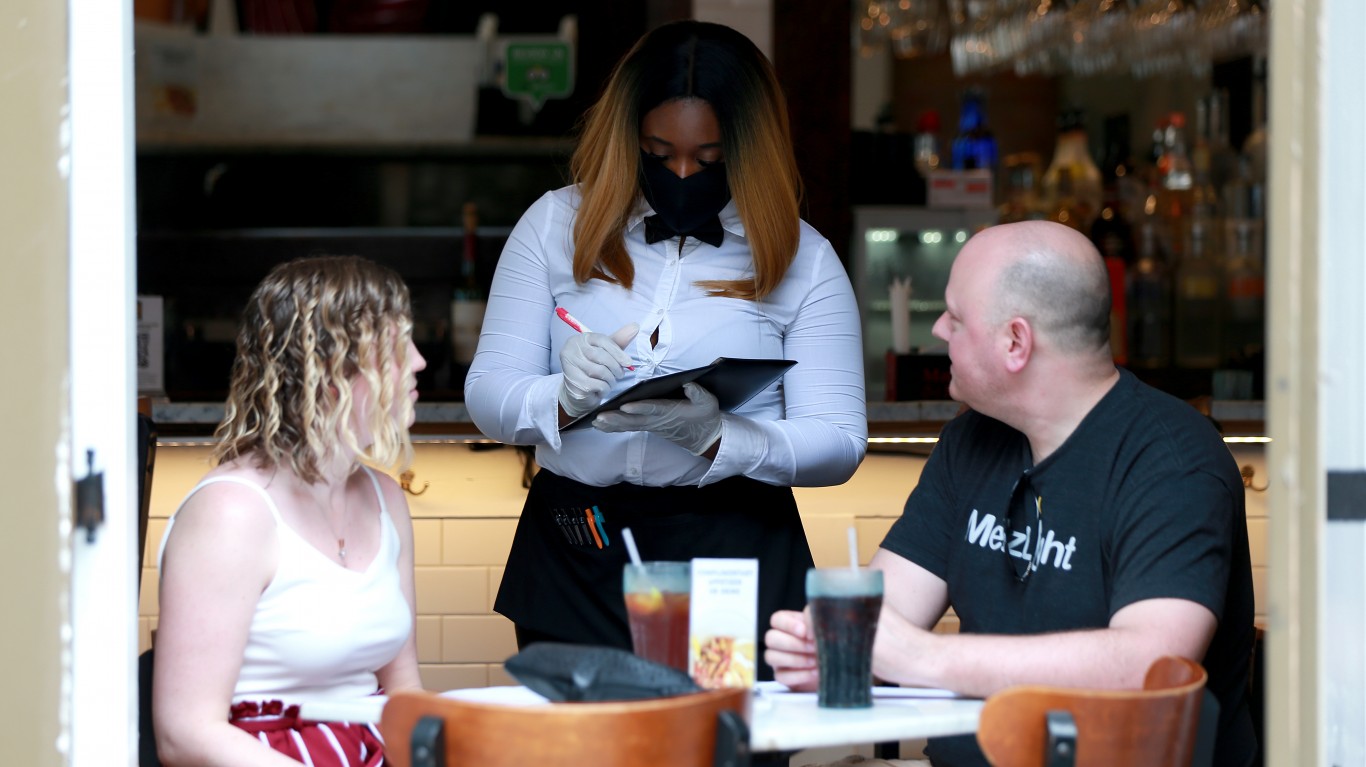
Louisiana
> Cumulative COVID-19 cases as of July 15: 1,761 per 100,000 people — 4th biggest (total: 82,042)
> COVID-19-related deaths as of July 15: 72 per 100,000 people — 6th biggest (total: 3,337)
> Total tests administered as of July 15: 20,954 per 100,000 people — 2nd biggest (total: 976,455)
> Change in trailing 7-day avg. daily cases, June 7 – July 14: 20.2% — 16th biggest increase (from 68,263 to 82,042)
> Population: 4,659,978
The state is in phase 2 of reopening and will remain in phase 2 due to the rising numbers of new COVID-19 cases and hospitalizations. There is now a statewide mask mandate, and bars are ordered to close again for in-person consumption. Gatherings of more than 50 people, except in churches, are now prohibited. Until recently, that limit was 250 people.
In phase 2, places of worship and businesses that were already allowed to open can expand to 50% capacity with social distancing. These businesses include massage and tattoo parlors, spas, bars and breweries with food permits, bowling alleys, arcades, pool halls, casinos and video poker, trampoline parks, event centers and wedding venues, and outdoor playgrounds and play centers. Employees who work with the public must wear face coverings. Businesses are strongly encouraged to offer temperature checks to patrons.

Maine
> Cumulative COVID-19 cases as of July 15: 267 per 100,000 people — 6th smallest (total: 3,578)
> COVID-19-related deaths as of July 15: 9 per 100,000 people — 9th smallest (total: 114)
> Total tests administered as of July 15: 9,332 per 100,000 people — 16th smallest (total: 124,905)
> Change in trailing 7-day avg. daily cases, June 7 – July 14: 3.7% — 7th smallest increase (from 3,440 to 3,566)
> Population: 1,338,404
All counties in Maine are allowed to reopen indoor dining with additional health and safety protocols. Bars, breweries, and tasting rooms can reopen for outdoor, seated service. Indoor service was supposed to resume July 1, but that has been postponed indefinitely due to coronavirus outbreaks in the state linked to indoor bars.
Gyms, tattoo parlors, and nail salons can open while adhering to requirements such as wearing masks and maintaining physical distance. Gatherings of people were increased to 50 from 10. There are now prevention checklists available for businesses such as spas and movie theaters that wish to reopen in phase 3.
[in-text-ad-2]
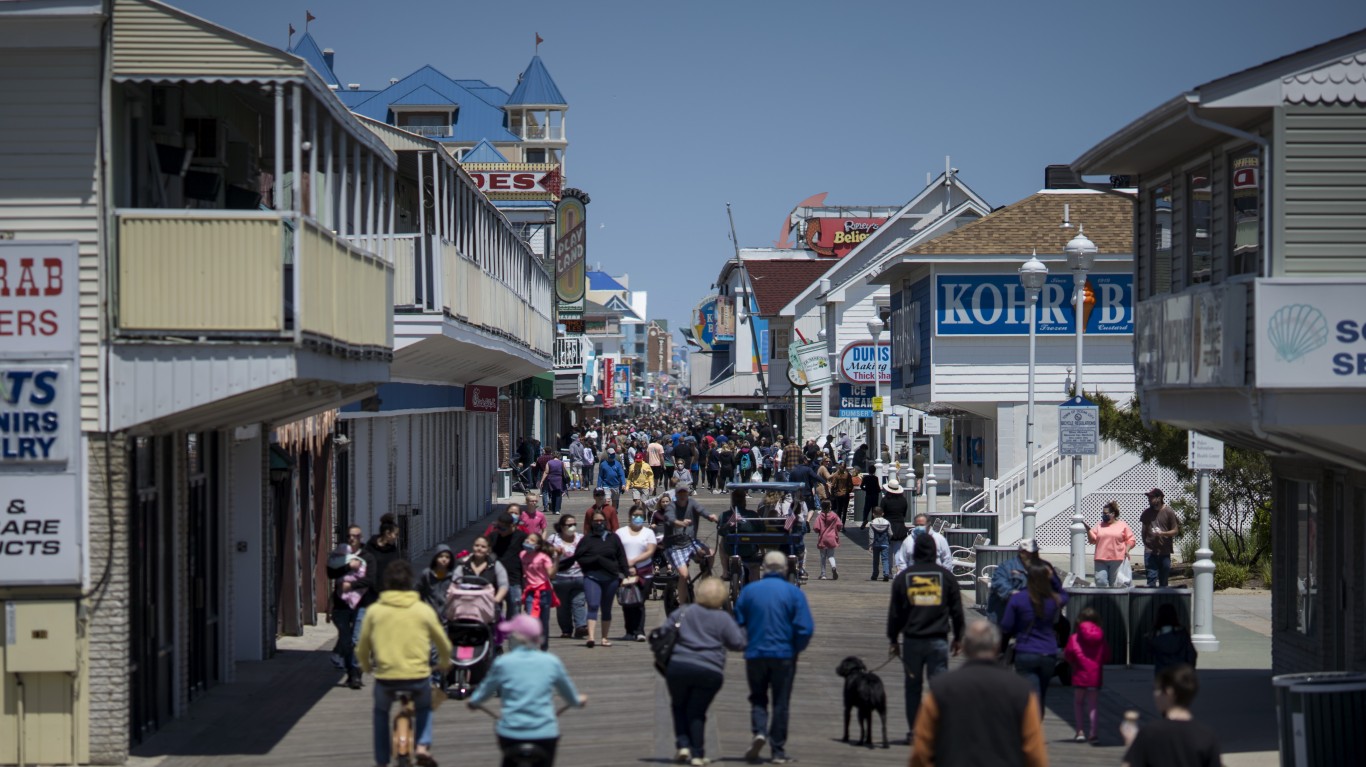
Maryland
> Cumulative COVID-19 cases as of July 15: 1,241 per 100,000 people — 11th biggest (total: 75,016)
> COVID-19-related deaths as of July 15: 55 per 100,000 people — 9th biggest (total: 3,341)
> Total tests administered as of July 15: N/A
> Change in trailing 7-day avg. daily cases, June 7 – July 14: 5.5% — 12th smallest increase (from 70,396 to 74,260)
> Population: 6,042,718
Maryland is in phase 2 of its reopening plan. Restaurants can open indoor dining at 50% capacity. Indoor gyms, martial arts, dance, and other indoor fitness studio activities can resume activities at 50% capacity. All child care providers may reopen, with up to 15 people per room. Employees able to telework are encouraged to continue to do so. Other guidance from the state for the workplace includes wearing face coverings, conducting temperature checks for workers, implementing split schedules, and staggering shifts.
Outdoor high school sports can resume practices and training activities. Nursing homes are allowed to resume limited outdoor visitation as well as small group activities with proper precautions.
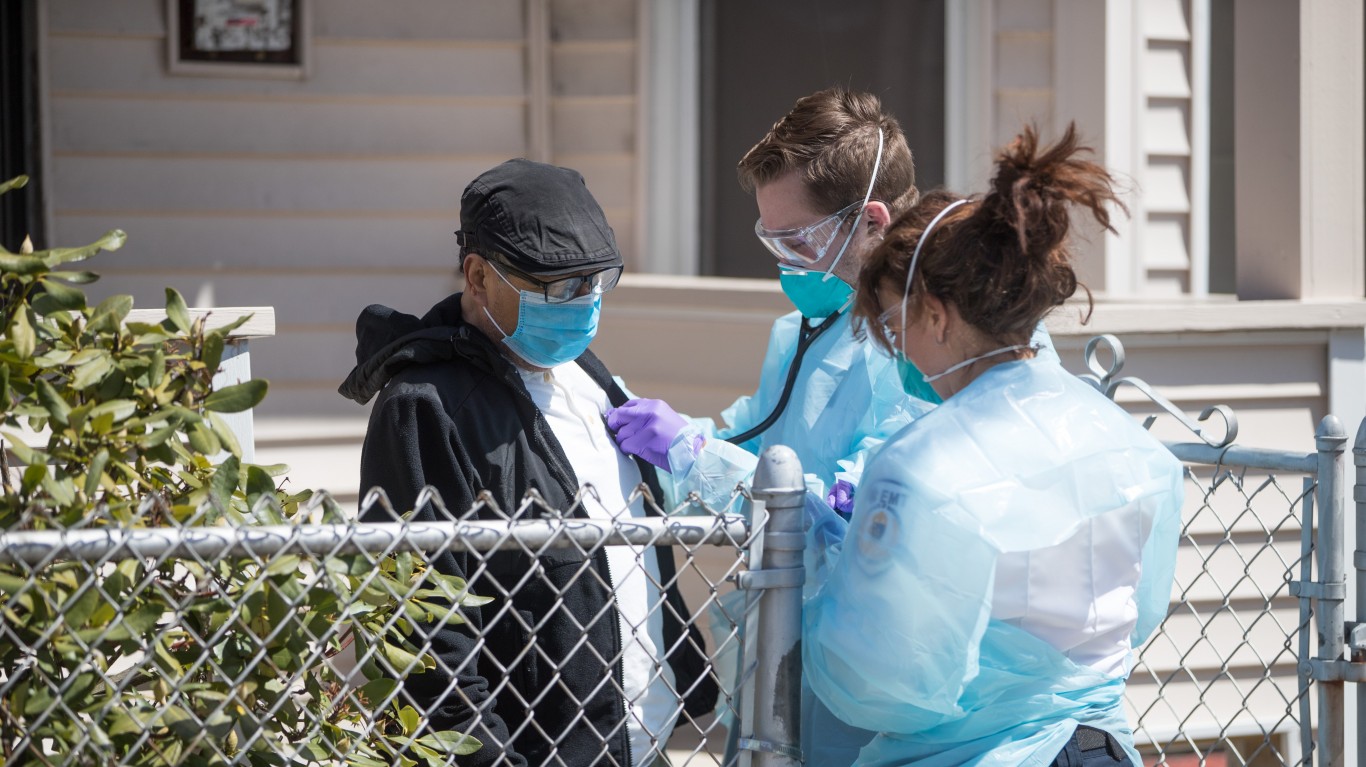
Massachusetts
> Cumulative COVID-19 cases as of July 15: 1,625 per 100,000 people — 6th biggest (total: 112,130)
> COVID-19-related deaths as of July 15: 121 per 100,000 people — 4th biggest (total: 8,340)
> Total tests administered as of July 15: 14,084 per 100,000 people — 14th biggest (total: 972,070)
> Change in trailing 7-day avg. daily cases, June 7 – July 14: 1.6% — 4th smallest increase (from 110,338 to 112,130)
> Population: 6,902,149
Massachusetts, except for Boston, started phase 3 of reopening on July 6. Movie theaters, outdoor performance venues, museums, cultural and historical sites, fitness centers, health clubs, and some low-contact indoor recreational activities can now resume but with capacity restrictions. Professional sports teams can hold games without a live audience.
Indoor gatherings are limited to eight people per 1,000 square feet but cannot exceed 25 people in a single enclosed space. Outdoor gatherings in enclosed spaces are limited to 25% occupancy with no more than 100 people in a single enclosed outdoor space.
[in-text-ad]

Michigan
> Cumulative COVID-19 cases as of July 15: 779 per 100,000 people — 23rd smallest (total: 77,864)
> COVID-19-related deaths as of July 15: 63 per 100,000 people — 7th biggest (total: 6,326)
> Total tests administered as of July 15: 13,537 per 100,000 people — 16th biggest (total: 1,353,182)
> Change in trailing 7-day avg. daily cases, June 7 – July 14: 5.4% — 11th smallest increase (from 73,269 to 77,198)
> Population: 9,995,915
On July 1, Gov. Gretchen Whitmer signed an executive order closing indoor service at bars in most of the lower part of the state because of recent outbreaks linked to bars. People statewide are required to wear non-medical grade face coverings in closed public spaces. Employers are obliged to provide masks to employees who are back in the office. Phase 5 of reopening in some regions was postponed due to isolated outbreaks of new COVID-19 cases in some parts of the state.
Retailers are open in Michigan, but with capacity limits. Swimming pools, libraries, museums, and day camps for children can open as well. Groups of up to 250 people are allowed to gather outdoors. Indoor gatherings are limited to 10 people. Outdoor performance and sporting venues can reopen but with a capacity of no more than 500 people with social distancing. Hair salons and similar personal care businesses can resume services with some restrictions.

Minnesota
> Cumulative COVID-19 cases as of July 15: 769 per 100,000 people — 22nd smallest (total: 43,170)
> COVID-19-related deaths as of July 15: 27 per 100,000 people — 18th biggest (total: 1,510)
> Total tests administered as of July 15: 13,858 per 100,000 people — 15th biggest (total: 777,614)
> Change in trailing 7-day avg. daily cases, June 7 – July 14: 10.3% — 19th smallest increase (from 39,133 to 43,170)
> Population: 5,611,179
Minnesota is in phase 3 of reopening. The plan allows for the limited reopening of indoor dining, gyms, and entertainment venues. Restaurants can open indoor dining at 50% capacity, but reservations are required. Gyms, movie theaters, and other indoor entertainment venues can open at 25% capacity. Hair salons, barbershops, and tattoo parlors can expand to 50% capacity, but clients have to make reservations. Places of worship can expand to 50% capacity.
Outdoor event venues, including sporting events, concerts, and theaters, can open at 25% capacity. Indoor social gatherings are limited to 10 people. Outdoors, people can gather in groups of 25.
Mississippi
> Cumulative COVID-19 cases as of July 15: 1,257 per 100,000 people — 10th biggest (total: 37,542)
> COVID-19-related deaths as of July 15: 43 per 100,000 people — 12th biggest (total: 1,272)
> Total tests administered as of July 15: 11,715 per 100,000 people — 24th biggest (total: 349,869)
> Change in trailing 7-day avg. daily cases, June 7 – July 14: 16.5% — 23rd biggest increase (from 32,214 to 37,542)
> Population: 2,986,530
Gov. Tate Reeves’ Safe Return executive order was extended until July 20 following a recent spike in new COVID-19 cases in Mississippi. The order was amended to allow concession stands at outdoor sports complexes and multi-field complexes to open with restrictions. The state was supposed to be completely reopened by July 1, but further reopening plans were delayed indefinitely because of the rapid increase in cases in the state. Masks are mandatory in 13 counties.
Social gatherings must comply with social distancing requirements, with a limit of 50 people indoors and no more than 100 people outdoors. Gatherings where people cannot socially distance have limits of 20 people indoors and up to 50 people outside. Restaurants and bars can now have live music performances, with customers and musicians maintaining at least a 12-foot distance. Gyms and fitness centers can expand to 50% capacity. Outdoor and indoor arenas can open but limit seating to 25% capacity.
[in-text-ad-2]

Missouri
> Cumulative COVID-19 cases as of July 15: 471 per 100,000 people — 11th smallest (total: 28,826)
> COVID-19-related deaths as of July 15: 18 per 100,000 people — 22nd smallest (total: 1,093)
> Total tests administered as of July 15: 8,245 per 100,000 people — 13th smallest (total: 505,103)
> Change in trailing 7-day avg. daily cases, June 7 – July 14: 17.0% — 22nd biggest increase (from 24,629 to 28,826)
> Population: 6,126,452
Missouri is in phase 2 of reopening, which allows the maximum number of people gathering in one place to increase to 50 people from 10. Also in phase 2, businesses such as restaurants, places of worship, gyms, and salons may boost operations to 50% capacity as long as social distancing is followed.
Local officials still have the authority to put further restrictions in place. While Gov. Mike Parson declines to put a statewide mandate requiring wearing of masks or introduce new restrictions as the state consistently reports increases in daily new cases, he encourages practicing social distancing and wearing face covering when distancing is difficult to follow.

Montana
> Cumulative COVID-19 cases as of July 15: 184 per 100,000 people — 2nd smallest (total: 1,952)
> COVID-19-related deaths as of July 15: 3 per 100,000 people — 3rd smallest (total: 34)
> Total tests administered as of July 15: 11,428 per 100,000 people — 25th biggest (total: 121,396)
> Change in trailing 7-day avg. daily cases, June 7 – July 14: 47.1% — the biggest increase (from 1,327 to 1,952)
> Population: 1,062,305
Despite a recent increase in coronavirus cases in Montana, the state’s reopening plan has not changed. Montana is in phase 2 of reopening. Gatherings are now limited to a maximum of 50 people. Restaurants, bars, breweries distilleries, and casinos are allowed to expand to 75% capacity. Gyms, indoor group fitness classes, pools, and hot tubs can also operate at 75% capacity. Concert halls, bowling alleys, and other places of assembly can resume activities but with reduced capacity.
The 24-person cap per child care facility has been lifted. Employers should still allow employees to work remotely as much as possible. Glacier National Park began to reopen certain parts of the park on June 8. Areas of the west side of the park are open for day-use only. Montana’s gates to Yellowstone National Park in West Yellowstone, as well as Gardiner and Cooke City, are now open as well.
[in-text-ad]
Nebraska
> Cumulative COVID-19 cases as of July 15: 1,126 per 100,000 people — 17th biggest (total: 21,717)
> COVID-19-related deaths as of July 15: 15 per 100,000 people — 20th smallest (total: 286)
> Total tests administered as of July 15: 11,403 per 100,000 people — 25th smallest (total: 219,996)
> Change in trailing 7-day avg. daily cases, June 7 – July 14: 6.7% — 15th smallest increase (from 20,046 to 21,399)
> Population: 1,929,268
Nebraska is in phase 3 of reopening. In phase 3, restaurants and bars can expand to 100% occupancy with no more than eight people per table. Self-serve buffets and salad bars are still banned. Gyms, fitness centers, and health clubs can operate at 75% capacity. Personal care service businesses can operate at 75% capacity, but everyone has to wear a mask. Indoor gatherings can expand to 50% of rated occupancy, and outdoor gatherings can expand to 75%.
Statewide, fan attendance for youth and school games is no longer limited to household members only. Contact team sports began practices and games after July 1. Drive-in movies can resume, but people must remain inside their cars. A modified Nebraska State Fair will take place Aug. 28-Sept. 7.

Nevada
> Cumulative COVID-19 cases as of July 15: 976 per 100,000 people — 20th biggest (total: 29,619)
> COVID-19-related deaths as of July 15: 20 per 100,000 people — 25th biggest (total: 612)
> Total tests administered as of July 15: 14,908 per 100,000 people — 11th biggest (total: 452,381)
> Change in trailing 7-day avg. daily cases, June 7 – July 14: 19.9% — 17th biggest increase (from 23,785 to 28,515)
> Population: 3,034,392
The state is in phase 2 of reopening and will remain in it at least until the end of July due to a surge in new coronavirus cases in the state. People have been required to wear masks anywhere in public. Bars that don’t serve food were ordered to close after being open for a few weeks, and restaurants can no longer serve tables with six or more customers.
Phase 2 allows salons and tattoo parlors to open. Pools, museums, zoos, malls, bowling alleys, movie theaters, and more are also allowed to reopen with reduced capacity. Live events such as sports, concerts, and theater performances may be held for broadcast, with no in-person spectators allowed. Local officials have the authority to tighten restrictions in their area if necessary.
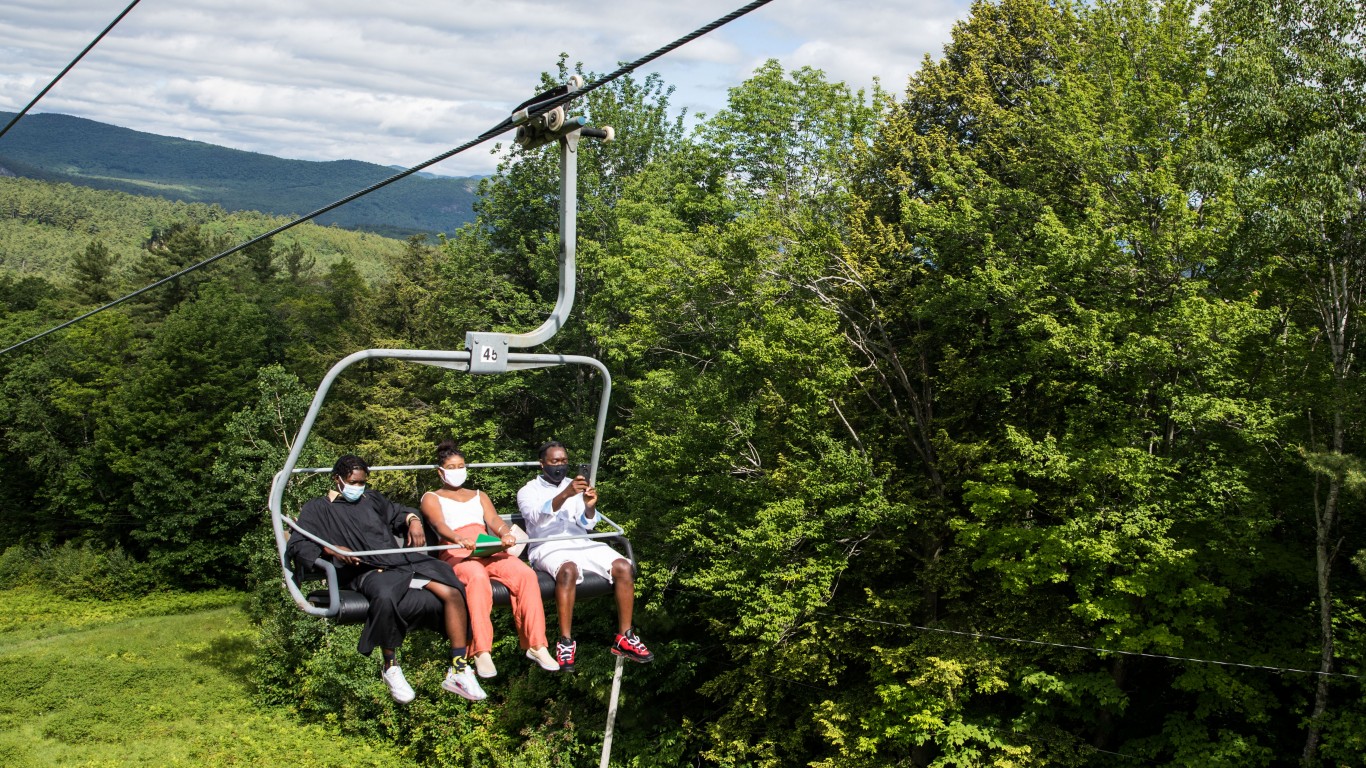
New Hampshire
> Cumulative COVID-19 cases as of July 15: 449 per 100,000 people — 9th smallest (total: 6,091)
> COVID-19-related deaths as of July 15: 29 per 100,000 people — 17th biggest (total: 392)
> Total tests administered as of July 15: 10,108 per 100,000 people — 20th smallest (total: 137,109)
> Change in trailing 7-day avg. daily cases, June 7 – July 14: 2.7% — 6th smallest increase (from 5,932 to 6,091)
> Population: 1,356,458
Services like salons, massage therapy centers, and tattoo shops have reopened in New Hampshire. Beach activities are now allowed at state seacoast beaches. Gyms can open at 50% capacity. Bowling alleys, libraries, funeral homes, museums, art galleries, and pools can also open. Outdoor attractions such as tourist trains can resume. Overnight summer camps can open a week after that. Indoor movie theaters, performing arts centers, and amusement parks can all open with capacity limits.
Larger hotels, inns, and campgrounds can operate at 100% capacity. The New Hampshire Motor Speedway will host the rescheduled NASCAR Cup Series Foxwoods Resort Casino 301 on Aug. 2, with the grandstands at up to 50% capacity. There is no longer a quarantine requirement for people coming from Maine, Vermont, Massachusetts, Connecticut, or Rhode Island for recreational activities.
[in-text-ad-2]
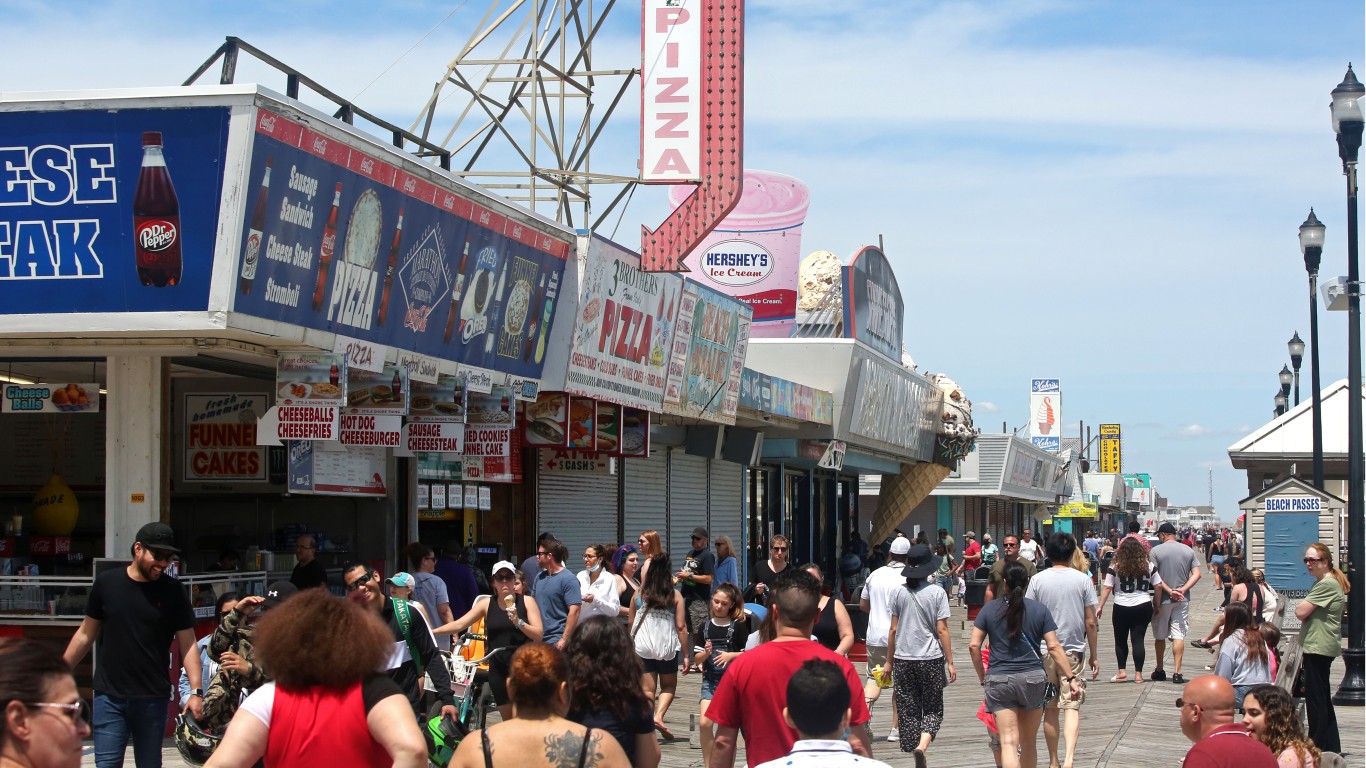
New Jersey
> Cumulative COVID-19 cases as of July 15: 1,975 per 100,000 people — 2nd biggest (total: 175,915)
> COVID-19-related deaths as of July 15: 153 per 100,000 people — the biggest (total: 13,635)
> Total tests administered as of July 15: 19,321 per 100,000 people — 5th biggest (total: 1,721,231)
> Change in trailing 7-day avg. daily cases, June 7 – July 14: 1.2% — 3rd smallest increase (from 173,878 to 175,915)
> Population: 8,908,520
New Jersey is in phase 2 of reopening. On July 8, Gov. Phil Murphy issued an executive order requiring people to wear face coverings in outdoor public settings where social distancing is not possible. Face coverings are also required in indoor spaces such as retail and recreational businesses and mass transit. Plans to resume indoor dining have been postponed indefinitely.
Traditional practices and competitions were allowed to resume after July 6 for medium-risk sports and after July 20 for high-risk sports. Amusement parks, casinos, and playgrounds statewide are allowed to reopen. The limit on outdoor gatherings was raised to 500 people on July 3. People can gather outside in groups of 100.
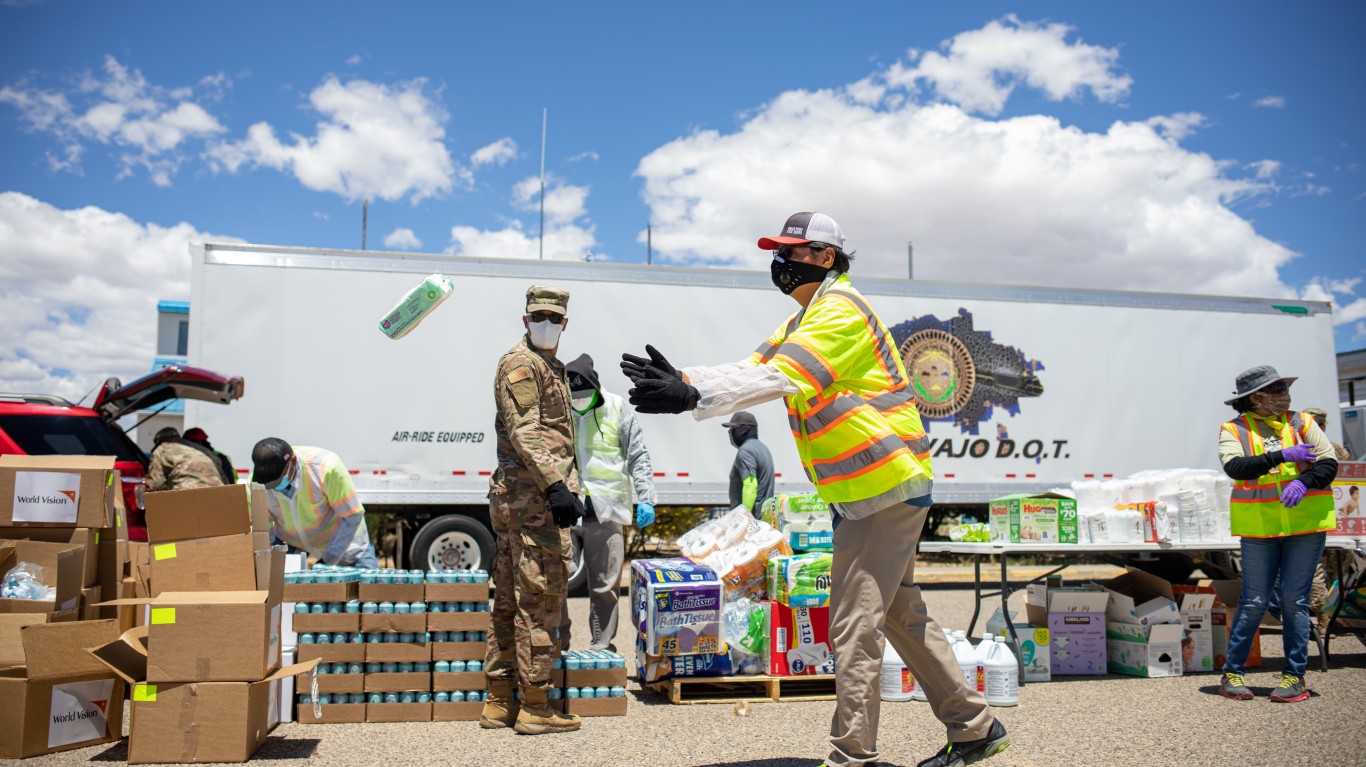
New Mexico
> Cumulative COVID-19 cases as of July 15: 740 per 100,000 people — 20th smallest (total: 15,514)
> COVID-19-related deaths as of July 15: 26 per 100,000 people — 19th biggest (total: 551)
> Total tests administered as of July 15: 20,521 per 100,000 people — 3rd biggest (total: 430,006)
> Change in trailing 7-day avg. daily cases, June 7 – July 14: 13.0% — 22nd smallest increase (from 13,727 to 15,514)
> Population: 2,095,428
Due to a spike in new coronavirus cases in New Mexico, indoor dining at restaurants has been banned, and bars have been ordered to close at least through July 30. Outdoor seating at restaurants and breweries is allowed at no more than 50% capacity. Close contact businesses such as tattoo shops and personal service salons are now limited to 25%; gyms to 25% as well, down from 50% before the new order. State parks are closed again for out-of-state visitors.
COVID-19 testing sites located throughout the state now offer free testing on Mondays for employees at restaurants, farmers’ markets, food manufacturing facilities, and grocery stores.
[in-text-ad]

New York
> Cumulative COVID-19 cases as of July 15: 2,063 per 100,000 people — the biggest (total: 403,175)
> COVID-19-related deaths as of July 15: 128 per 100,000 people — 2nd biggest (total: 24,994)
> Total tests administered as of July 15: 24,485 per 100,000 people — the biggest (total: 4,784,927)
> Change in trailing 7-day avg. daily cases, June 7 – July 14: 1.0% — the smallest increase (from 398,237 to 402,263)
> Population: 19,542,209
Businesses in New York state can deny entry to people without masks. In-person special education instruction can take place over the summer. Five regions are in phase 4 of reopening — Central New York, Finger Lakes, Mohawk Valley, North Country, and Southern Tier. In phase 4, gatherings of up to 50 people are allowed, an increase from 25 allowed in phase 3. Malls can reopen if they have implemented an enhanced heating, ventilation and air conditioning filtration system.
New York City entered phase 3 on July 6. Personal care services can open but limit workforce and customer presence to 50% of maximum occupancy. However, in the food service industry, indoor dining has been postponed. Outdoors, tables must be located at least 6 feet apart.
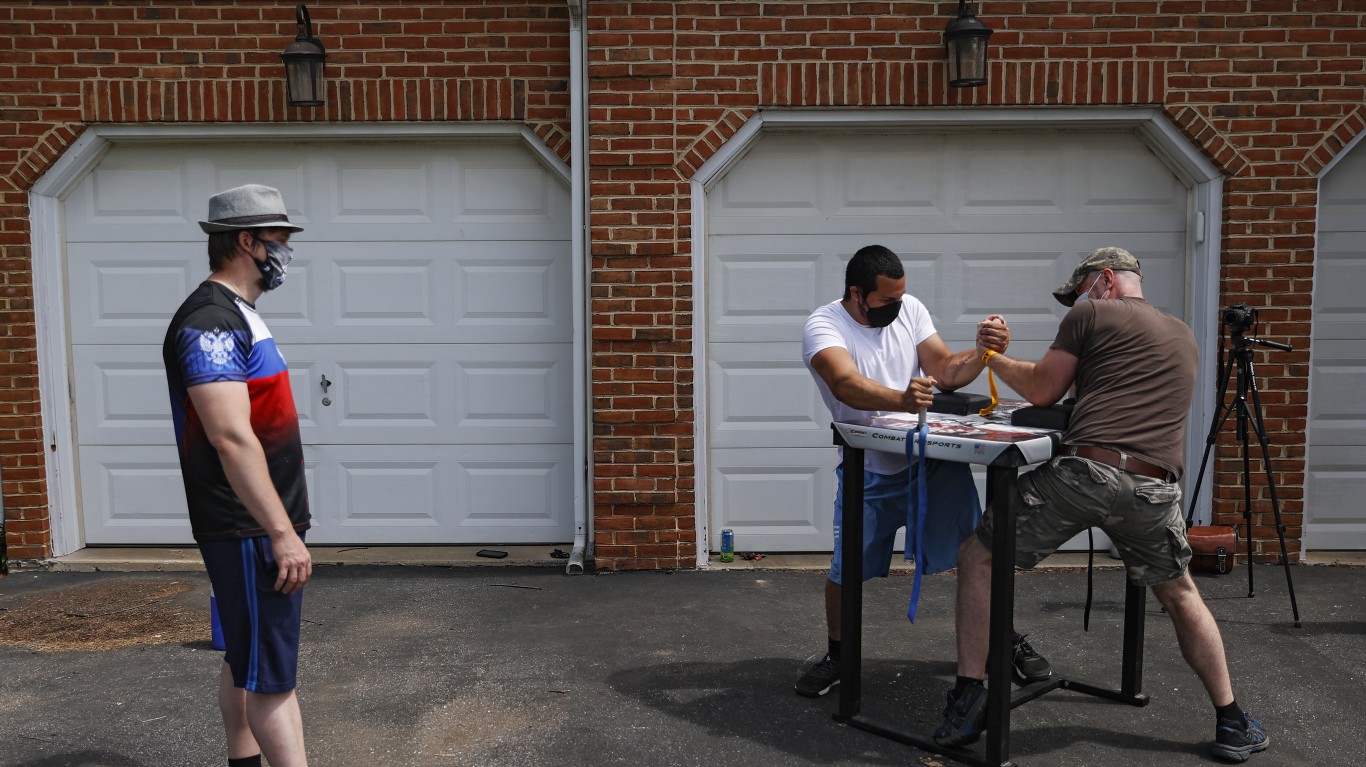
North Carolina
> Cumulative COVID-19 cases as of July 15: 862 per 100,000 people — 24th biggest (total: 89,484)
> COVID-19-related deaths as of July 15: 15 per 100,000 people — 21st smallest (total: 1,552)
> Total tests administered as of July 15: 12,085 per 100,000 people — 21st biggest (total: 1,254,846)
> Change in trailing 7-day avg. daily cases, June 7 – July 14: 17.9% — 20th biggest increase (from 75,875 to 89,484)
> Population: 10,383,620
Phase 2 of reopening North Carolina was set to expire on June 26, but the state paused further reopening plans due to a surge in new COVID-19 cases. People in the state are now required to wear face coverings when in public, making the state the first in the South to issue such a mandate. Children under 11, people with preexisting conditions, and those exercising outdoors are exempt.
Gatherings of up to 10 people indoors and 25 people outdoors are allowed. Restaurants are now open but must operate at 50% capacity and follow strict sanitation and social distancing guidelines. Bars and gyms are to remain closed.
North Dakota
> Cumulative COVID-19 cases as of July 15: 591 per 100,000 people — 15th smallest (total: 4,493)
> COVID-19-related deaths as of July 15: 12 per 100,000 people — 16th smallest (total: 88)
> Total tests administered as of July 15: 16,450 per 100,000 people — 8th biggest (total: 125,033)
> Change in trailing 7-day avg. daily cases, June 7 – July 14: 15.3% — 24th smallest increase (from 3,898 to 4,493)
> Population: 760,077
Movie theaters, gyms, salons, tattoo parlors, bars, and restaurants are open. Bars and restaurants are now allowed to increase capacity to 75%; movie theaters are allowed to increase capacity to 65%; and fitness centers may consider resuming classes with social distancing. The recommended capacity for banquets and weddings increased to 75% of venue occupancy, but to no more than 500 people.
Long-term care facilities can start a phased approach to resuming visitation, preferably outdoors. Visitors should make an appointment. Nursing homes approved for phase 1 can resume group dining and other activities such as bingo.
[in-text-ad-2]
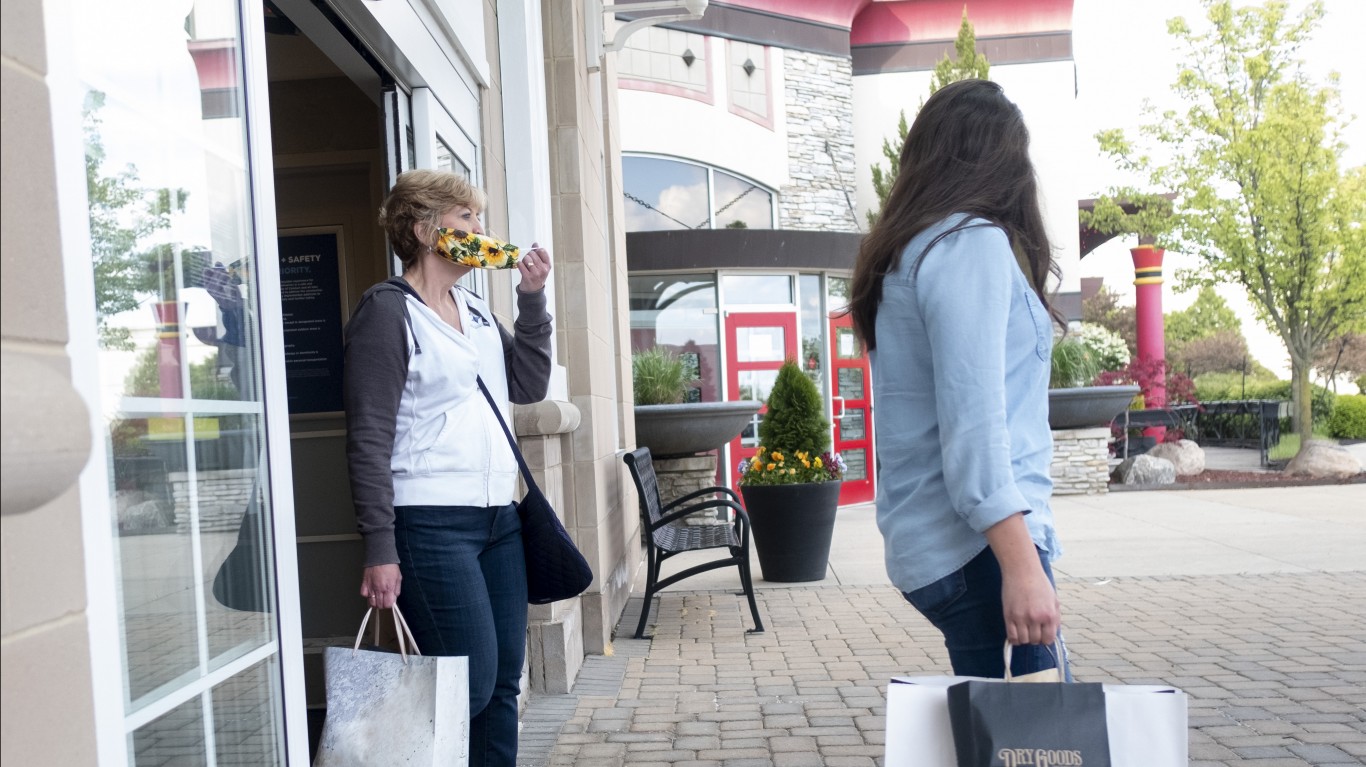
Ohio
> Cumulative COVID-19 cases as of July 15: 582 per 100,000 people — 14th smallest (total: 67,995)
> COVID-19-related deaths as of July 15: 26 per 100,000 people — 20th biggest (total: 3,069)
> Total tests administered as of July 15: N/A
> Change in trailing 7-day avg. daily cases, June 7 – July 14: 15.4% — 25th smallest increase (from 58,904 to 67,995)
> Population: 11,689,442
People are required to wear face coverings when in public. Gyms and fitness centers are able to reopen, and non-contact and limited-contact sports can resume with safety protocols in place. Public and club pools can reopen as can miniature golf, batting cages, and bowling alleys. Catering and banquet centers can reopen if tables are at least 6 feet apart and gatherings should not exceed 300 people. Entertainment facilities such as country clubs, indoor movie theaters, outdoor playgrounds, trampoline parks, and zoos can now also open.
Contact practice for all sports are allowed to resume, as long as participants adhere to safety protocols.

Oklahoma
> Cumulative COVID-19 cases as of July 15: 551 per 100,000 people — 12th smallest (total: 21,738)
> COVID-19-related deaths as of July 15: 11 per 100,000 people — 12th smallest (total: 428)
> Total tests administered as of July 15: N/A
> Change in trailing 7-day avg. daily cases, June 7 – July 14: 26.2% — 7th biggest increase (from 17,220 to 21,738)
> Population: 3,943,079
The state is in phase 3 of reopening. Businesses can now resume staffing at their work sites, but social distancing guidelines must be followed. Businesses that were operating by appointment only can now start accepting walk-ins. Summer camps can open in line with safety guidelines. Limited visitation to hospitals may resume. Visitation at nursing homes and long-term care facilities can now resume in a phased approach.
Restrictions on salons, barbers, and pet groomers have been lifted. Restaurant dining, movie theaters, gyms, houses of worship, and sporting venues are allowed to reopen with certain restrictions, including adhering to strict social distancing and sanitation protocols. ShowBiz Cinemas temporarily closed all locations in the state, after being open for a few weeks, (as well as in Texas) due to the pandemic, and movie release dates are continuing to change.
[in-text-ad]

Oregon
> Cumulative COVID-19 cases as of July 15: 306 per 100,000 people — 7th smallest (total: 12,805)
> COVID-19-related deaths as of July 15: 6 per 100,000 people — 6th smallest (total: 244)
> Total tests administered as of July 15: 7,273 per 100,000 people — 10th smallest (total: 304,802)
> Change in trailing 7-day avg. daily cases, June 7 – July 14: 20.7% — 14th biggest increase (from 10,605 to 12,805)
> Population: 4,190,713
A stay-at-home order is in effect in Oregon until further notice. Counties can begin lifting some restrictions when they meet certain requirements and must stay in phase 1 of the reopening for at least three weeks.
However, due to a surge in new COVID-19 cases in the state, all phase 1 counties will not be eligible to progress to phase 2 for at least 21 days. As of July 1, a statewide order mandated that people wear face coverings in indoor public spaces and outside. Indoor gatherings of more than 10 people are now banned.

Pennsylvania
> Cumulative COVID-19 cases as of July 15: 755 per 100,000 people — 21st smallest (total: 96,671)
> COVID-19-related deaths as of July 15: 54 per 100,000 people — 10th biggest (total: 6,931)
> Total tests administered as of July 15: N/A
> Change in trailing 7-day avg. daily cases, June 7 – July 14: 5.9% — 14th smallest increase (from 91,299 to 96,671)
> Population: 12,807,060
As of July 3, Pennsylvania was in a green phase of reopening, which is the third phase of easing restrictions on businesses and movement. Businesses can increase capacity to 75%, up from 50% under the yellow phase. Child care facilities can also reopen. Large gatherings are allowed but cannot exceed 250 people. Personal care services can open at 50% capacity and only by appointment. Entertainment venues are allowed to open at 50% as well. People are required to wear a mask when in public.
Due to a recent spike in coronavirus cases in western Pennsylvania, restaurants in several counties, including Beaver, were ordered to close for indoor dining again. Bars have to shut down as well in those countries, and gatherings are limited to 25 people. Allegheny County, which includes Pittsburgh, shut down bars and indoor dining in food establishments as well.

Rhode Island
> Cumulative COVID-19 cases as of July 15: 1,663 per 100,000 people — 5th biggest (total: 17,588)
> COVID-19-related deaths as of July 15: 93 per 100,000 people — 5th biggest (total: 985)
> Total tests administered as of July 15: 16,519 per 100,000 people — 6th biggest (total: 174,658)
> Change in trailing 7-day avg. daily cases, June 7 – July 14: 2.2% — 5th smallest increase (from 17,204 to 17,588)
> Population: 1,057,315
People are required to wear masks indoors as well as outdoors if they can’t maintain 6 feet of distance. The state has been in phase 3 of reopening since June 30. Social gatherings are now limited to 25 people indoors and 50 people outdoors. Weddings at venues can have 50 guests indoors and 100 people outdoors. Indoor venues that were operating at limited capacity during phase 2 can expand to 66% capacity as long as 6-foot spacing is maintained. Bars are limited to table service only.
Rhode Island now has a 14-day quarantine order that affects those travelling from states with positive test rates of 5% or greater as well as Puerto Rico. The state will be testing visitors coming from coronavirus hot spots.
[in-text-ad-2]

South Carolina
> Cumulative COVID-19 cases as of July 15: 1,188 per 100,000 people — 13th biggest (total: 60,389)
> COVID-19-related deaths as of July 15: 20 per 100,000 people — 25th smallest (total: 993)
> Total tests administered as of July 15: N/A
> Change in trailing 7-day avg. daily cases, June 7 – July 14: 27.5% — 6th biggest increase (from 47,352 to 60,389)
> Population: 5,084,127
South Carolina is one of the states where new COVID-19 cases and hospitalizations have been setting new records. Though the state of emergency order was extended, occupancy limits on retail businesses have been lifted. Bowling alleys are now open, but customers should bring their own bowling balls and shoes if possible. Traveling restrictions on visitors from high-risk areas have been lifted as well.
Residents are encouraged to work from home. Restaurants can choose to reopen for limited dine-in services if they follow state guidelines. Outdoor customer dining services are also allowed. Day camps can operate provided they comply with health and safety guidelines such as campers following physical distancing per groups.

South Dakota
> Cumulative COVID-19 cases as of July 15: 858 per 100,000 people — 25th biggest (total: 7,572)
> COVID-19-related deaths as of July 15: 12 per 100,000 people — 17th smallest (total: 109)
> Total tests administered as of July 15: 10,447 per 100,000 people — 22nd smallest (total: 92,164)
> Change in trailing 7-day avg. daily cases, June 7 – July 14: 5.7% — 13th smallest increase (from 7,163 to 7,572)
> Population: 882,235
The state never issued a statewide stay-at-home order, but it did institute some restrictions on gatherings and businesses. An order that required state residents to observe social distancing and CDC-recommended hygiene practices expired on May 31, but the state of emergency has been extended until Dec. 30.
Businesses are now allowed to reopen if the surrounding area has reported a downward trend in cases for two weeks. Employees can now be called back to the office, though administrative leave is allowed for those who cannot come in and cannot work remotely. For tourists, most attractions have reopened, including state and national parks as well as monuments and historic sites.
[in-text-ad]

Tennessee
> Cumulative COVID-19 cases as of July 15: 987 per 100,000 people — 19th biggest (total: 66,788)
> COVID-19-related deaths as of July 15: 11 per 100,000 people — 14th smallest (total: 767)
> Total tests administered as of July 15: 15,824 per 100,000 people — 10th biggest (total: 1,071,320)
> Change in trailing 7-day avg. daily cases, June 7 – July 14: 24.8% — 8th biggest increase (from 53,514 to 66,788)
> Population: 6,770,010
Groups of up to 50 people can gather outside in Tennessee for social and recreational purposes if they practice social distancing. Visitation at nursing homes and other long-term care facilities are allowed. Restaurants can offer in-person but limited-capacity dining. Noncontact sports, like baseball, golf, or tennis, also resumed.
Shelby County, which includes Memphis and is the largest county in the state, will remain in phase 2 of reopening due to a recent spike in daily new coronavirus cases. Though there is no statewide mandate, mayors in 89 of the state’s 95 counties now have the authority to issue face mask requirements. Due to a spike in COVID-19 cases in Tennessee, the state of emergency has been extended until the end of August, but bringing back restrictions on businesses and movement is not being considered, according to Gov. Bill Lee.

Texas
> Cumulative COVID-19 cases as of July 15: 958 per 100,000 people — 22nd biggest (total: 275,058)
> COVID-19-related deaths as of July 15: 12 per 100,000 people — 15th smallest (total: 3,322)
> Total tests administered as of July 15: 9,054 per 100,000 people — 15th smallest (total: 2,598,680)
> Change in trailing 7-day avg. daily cases, June 7 – July 14: 30.6% — 5th biggest increase (from 210,585 to 275,058)
> Population: 28,701,845
Texas is in phase 3 of reopening. All air travel restrictions, including mandatory quarantines for out-of-state travelers, have been lifted. Zoos and water parks are allowed to reopen with limited capacity. Amusement parks and carnivals in counties with more than 1,000 confirmed positive cases can open at 50% capacity.
Plans for further reopening have been halted due to a recent increase in new COVID-19 cases and hospitalizations in the state. Just like before restrictions were lifted, elective surgeries are banned to preserve bed space for coronavirus patients. Restaurants can operate at no more than 50% of their indoor capacity, down from 75%. Bars are closed. Texans are required to wear face coverings when out in public in counties with a total of 20 or more cases. Mayors can impose stricter restrictions on outdoor gatherings of more than 10 people.

Utah
> Cumulative COVID-19 cases as of July 15: 964 per 100,000 people — 21st biggest (total: 30,478)
> COVID-19-related deaths as of July 15: 07 per 100,000 people — 8th smallest (total: 226)
> Total tests administered as of July 15: 13,430 per 100,000 people — 17th biggest (total: 424,521)
> Change in trailing 7-day avg. daily cases, June 7 – July 14: 17.9% — 21st biggest increase (from 25,469 to 30,030)
> Population: 3,161,105
In-restaurant dining, gyms, and salons can open in Utah. Gatherings of up to 20 people are allowed. Malls and national parks can reopen under tight restrictions. People are still encouraged to avoid nonessential travel.
Utah delayed considering applications by counties to ease more restrictions due to an increase in new coronavirus cases in the state. Most of the state is still in the yellow (or low-risk) phase of reopening. In this phase, all economic activities are allowed if people practice social distancing and proper hygiene. There is no statewide mandate to wear masks in public (except in schools and government buildings), and there are no plans to roll back restrictions on businesses despite a spike in coronavirus cases.
[in-text-ad-2]
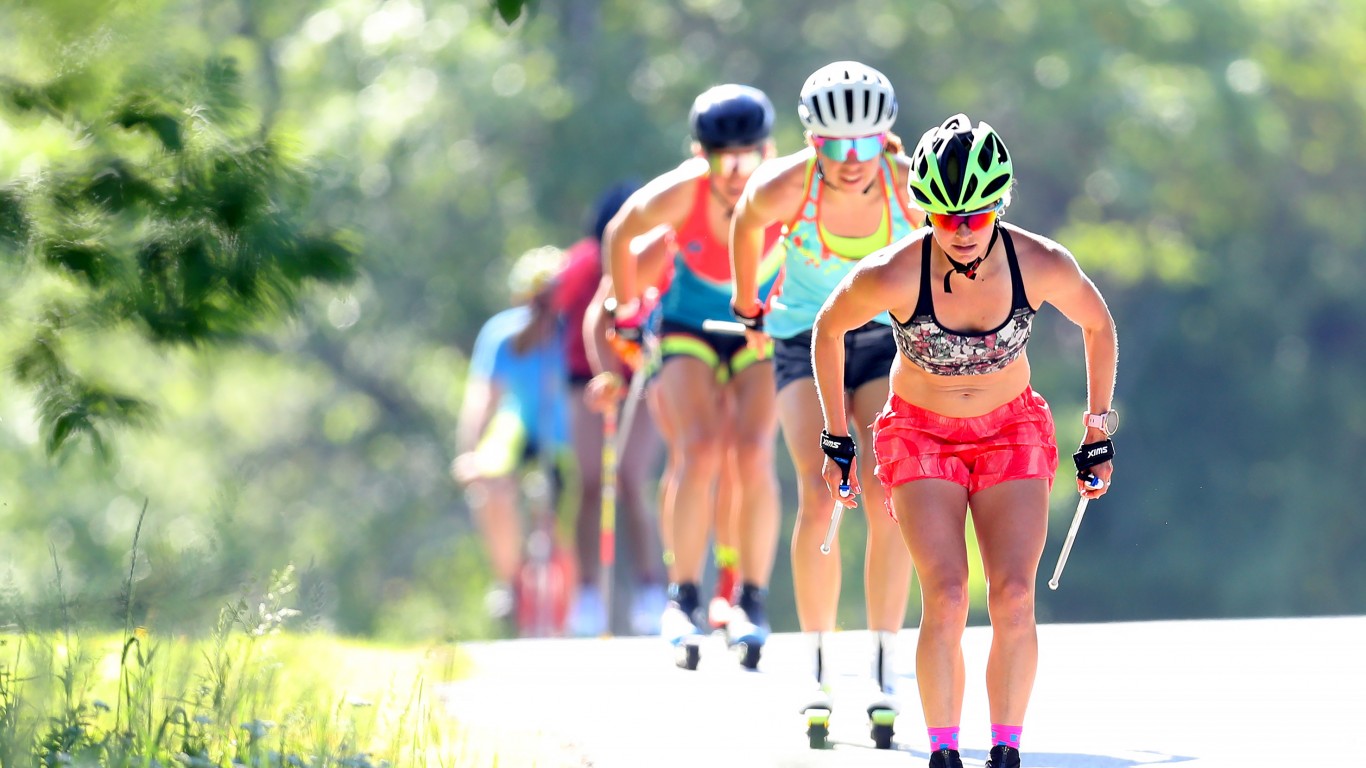
Vermont
> Cumulative COVID-19 cases as of July 15: 210 per 100,000 people — 3rd smallest (total: 1,318)
> COVID-19-related deaths as of July 15: 9 per 100,000 people — 10th smallest (total: 56)
> Total tests administered as of July 15: 12,511 per 100,000 people — 20th biggest (total: 78,358)
> Change in trailing 7-day avg. daily cases, June 7 – July 14: 4.1% — 8th smallest increase (from 1,254 to 1,305)
> Population: 626,299
Retail and lodging businesses have reopened in Vermont. Hair salons and barbershops can reopen but by appointment and with limits on occupancy. Transactions must be cashless and touchless, and owners must keep a customer log in case contact tracing is needed later.
Travel restrictions have been loosened. Out-of-state visitors can visit Vermont, but they have to complete a 14-day quarantine or a seven-day quarantine if they present a negative test result taken in their home state or in Vermont.
Events can have up to 75 people indoors and up to 150 outdoors. Arts, culture, and entertainment venues, as well as restaurants, can expand capacity to 50% or one person per 100 square feet.
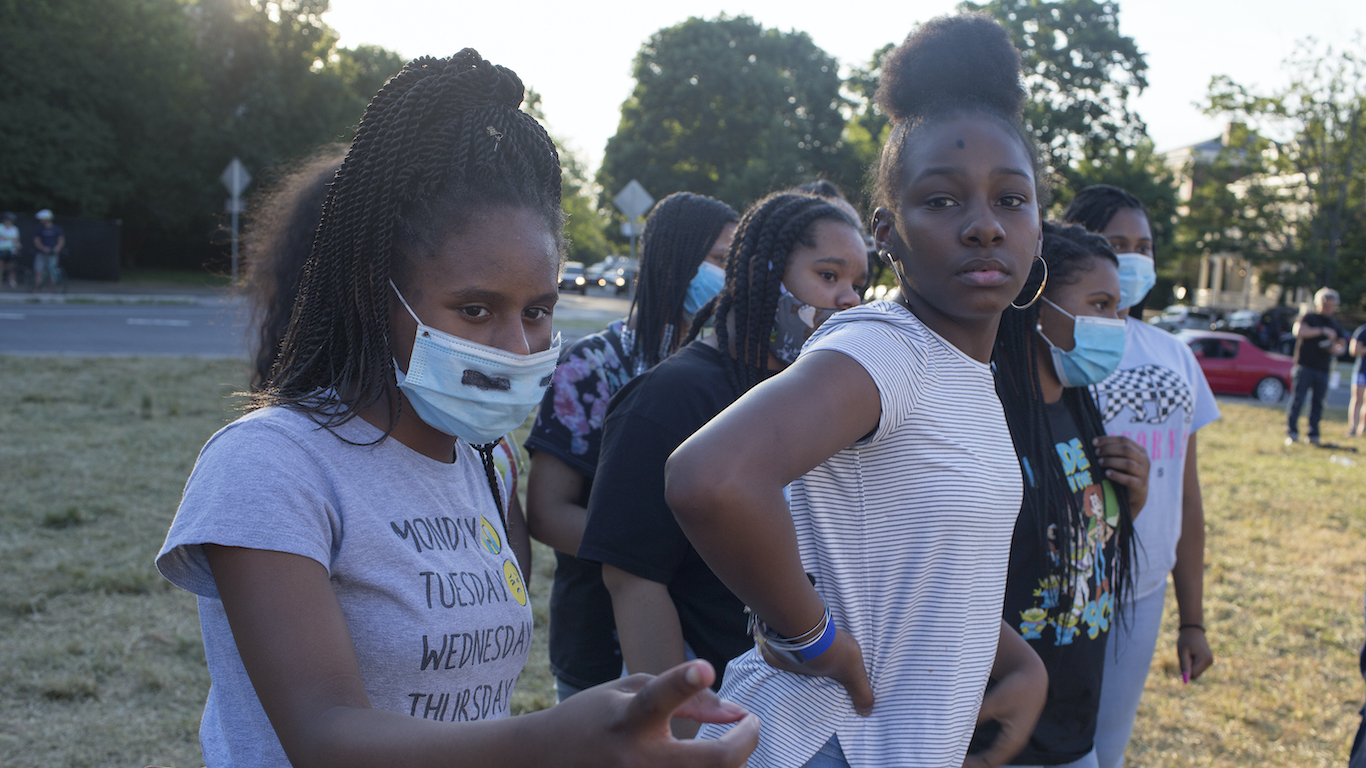
Virginia
> Cumulative COVID-19 cases as of July 15: 863 per 100,000 people — 23rd biggest (total: 73,527)
> COVID-19-related deaths as of July 15: 23 per 100,000 people — 22nd biggest (total: 1,992)
> Total tests administered as of July 15: 9,887 per 100,000 people — 18th smallest (total: 842,124)
> Change in trailing 7-day avg. daily cases, June 7 – July 14: 8.5% — 17th smallest increase (from 66,740 to 72,443)
> Population: 8,517,685
The state is currently in phase 3 of reopening. Social distancing and face coverings are still required. Social gathering limits are limited to 250 people or 50% of occupancy, whichever is less.
Fitness centers can open indoor areas at 75% occupancy. Recreation and entertainment venues may operate at 50% capacity or a maximum of 1,000 people. Swimming pools can open for swim, diving, and swim instruction. Overnight summer camps will remain closed. Restaurants are open, with restrictions, but bars and bar areas in restaurants remain closed.
[in-text-ad]

Washington
> Cumulative COVID-19 cases as of July 15: 561 per 100,000 people — 13th smallest (total: 42,304)
> COVID-19-related deaths as of July 15: 19 per 100,000 people — 24th smallest (total: 1,404)
> Total tests administered as of July 15: 9,531 per 100,000 people — 17th smallest (total: 718,234)
> Change in trailing 7-day avg. daily cases, June 7 – July 14: 12.9% — 21st smallest increase (from 36,985 to 41,757)
> Population: 7,535,591
A stay-at-home was replaced by a Safe Start reopening plan, which was extended until Aug. 6. The state put on hold plans to move to phase 4 of reopening, which would have meant even fewer restrictions on businesses and people’s movement.
In phase 3, people are allowed to gather outside in groups of no more than 50 people, and nonessential travel can resume. Also, recreational facilities can open at 50% capacity, restaurants can expand capacity to 75% capacity, bars can open at 25% capacity, and movie theaters can open at 50% capacity. Face coverings are required when in public across Washington state, and businesses may not service to customers who don’t comply. Bars, nightclubs, movie theaters, and concert and sporting venues are still closed.

West Virginia
> Cumulative COVID-19 cases as of July 15: 247 per 100,000 people — 5th smallest (total: 4,463)
> COVID-19-related deaths as of July 15: 5 per 100,000 people — 5th smallest (total: 97)
> Total tests administered as of July 15: 11,931 per 100,000 people — 23rd biggest (total: 215,450)
> Change in trailing 7-day avg. daily cases, June 7 – July 14: 24.6% — 10th biggest increase (from 3,461 to 4,313)
> Population: 1,805,832
Due to an increase in daily COVID-19 cases across West Virginia, the limit on social gatherings statewide has been reduced to 25 100 people. The limit does not apply to religious services, weddings, and other gatherings deemed essential. All fairs, festivals, indoor and outdoor concerts, and similar big events are banned. Bars in Monongalia County are ordered to shut down for 10 days.
State park cabins, museums, and zoos are open. Spas and massage businesses are open. So are swimming pools, bowling alleys, pool halls, roller rinks, other indoor amusement venues, and movie theaters. A statewide order requiring face coverings in indoor public places took effect on July 7.
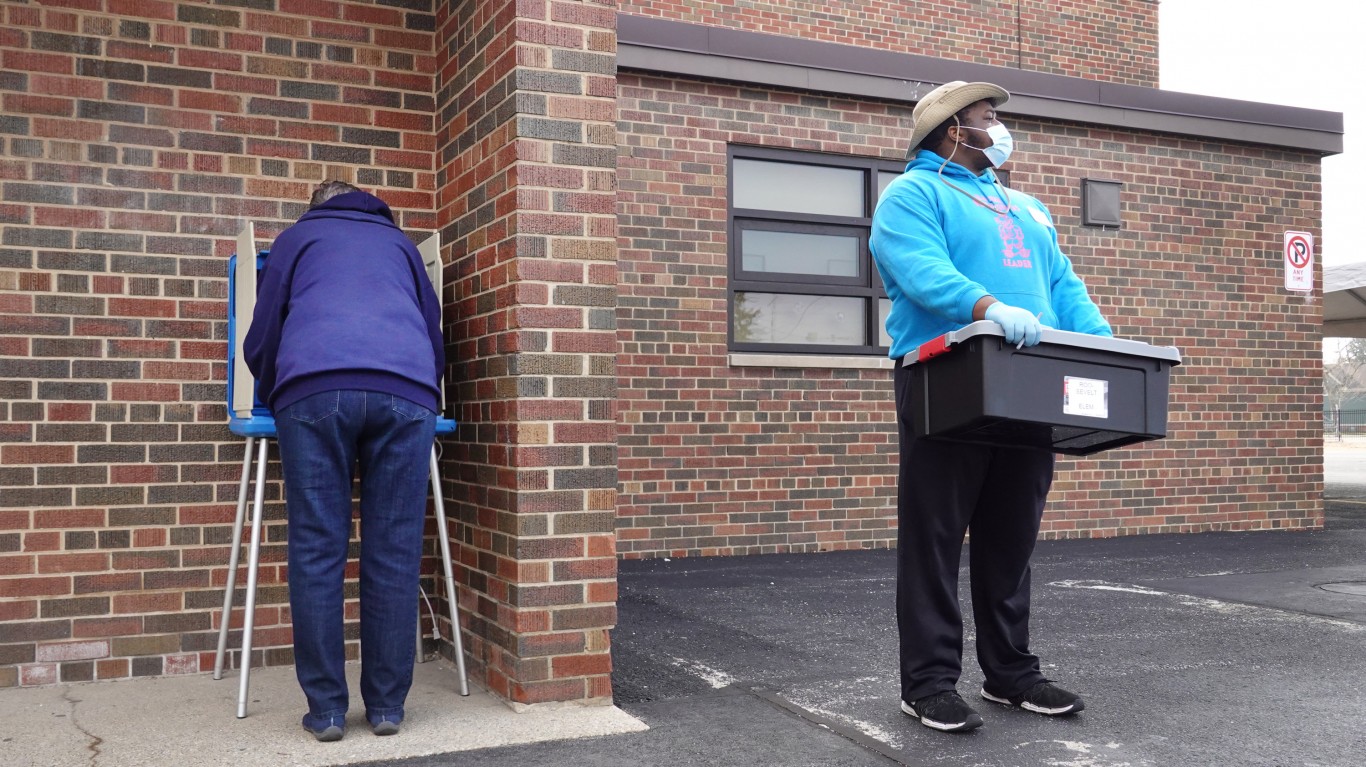
Wisconsin
> Cumulative COVID-19 cases as of July 15: 652 per 100,000 people — 16th smallest (total: 37,906)
> COVID-19-related deaths as of July 15: 14 per 100,000 people — 18th smallest (total: 826)
> Total tests administered as of July 15: N/A
> Change in trailing 7-day avg. daily cases, June 7 – July 14: 16.4% — 24th biggest increase (from 32,556 to 37,906)
> Population: 5,813,568
The Wisconsin Supreme Court struck down the stay-at-home order that was supposed to be in effect until May 26. Restrictions were then lifted. Though local officials imposed some minor restrictions. Milwaukee bars and restaurants can resume in-person service, though indoor dining must be capped at 25% capacity.
The state released guidelines for schools to reopen in the fall. Classes will be a combination of in-person, physically-distanced, and virtual learning. Classroom sizes will have to be reduced, which may make attending school in shifts necessary. Four-day school week — with the fifth day being designated for cleaning — is also an option.
[in-text-ad-2]
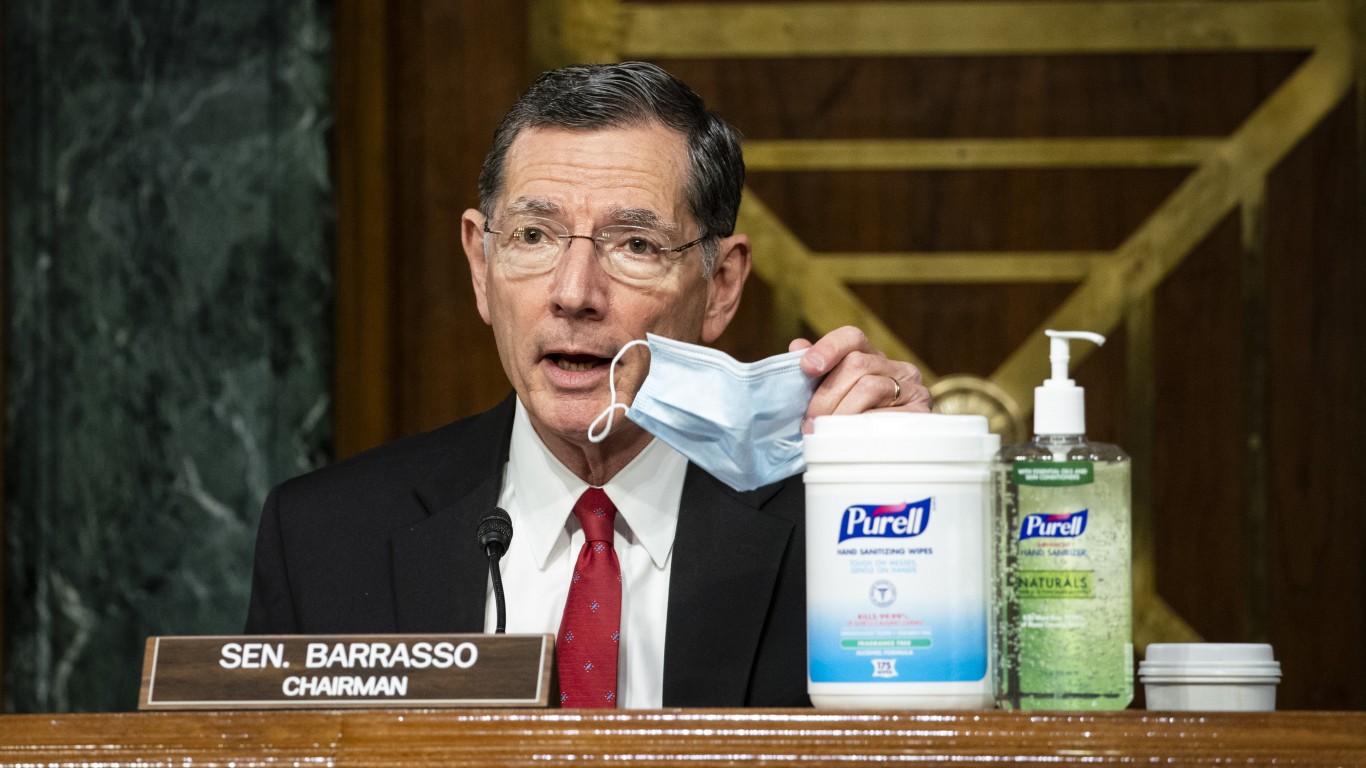
Wyoming
> Cumulative COVID-19 cases as of July 15: 338 per 100,000 people — 8th smallest (total: 1,951)
> COVID-19-related deaths as of July 15: 4 per 100,000 people — 4th smallest (total: 22)
> Total tests administered as of July 15: 6,846 per 100,000 people — 8th smallest (total: 39,552)
> Change in trailing 7-day avg. daily cases, June 7 – July 14: 13.6% — 23rd smallest increase (from 1,675 to 1,903)
> Population: 577,737
Outdoor gatherings of up to 250 people have been allowed since June 1, but people must practice social distancing. Schools, community colleges, the University of Wyoming and other educational institutions can resume in-person instruction, but fitness classes cannot be of no more than 50 people.
Personal care services no longer have to operate by appointment only. Long-term care facilities can now resume outdoor, in-person visitation under specific health guidelines. Though movie theaters are allowed to open, some have chosen to close again due to lack of customers.
Thank you for reading! Have some feedback for us?
Contact the 24/7 Wall St. editorial team.